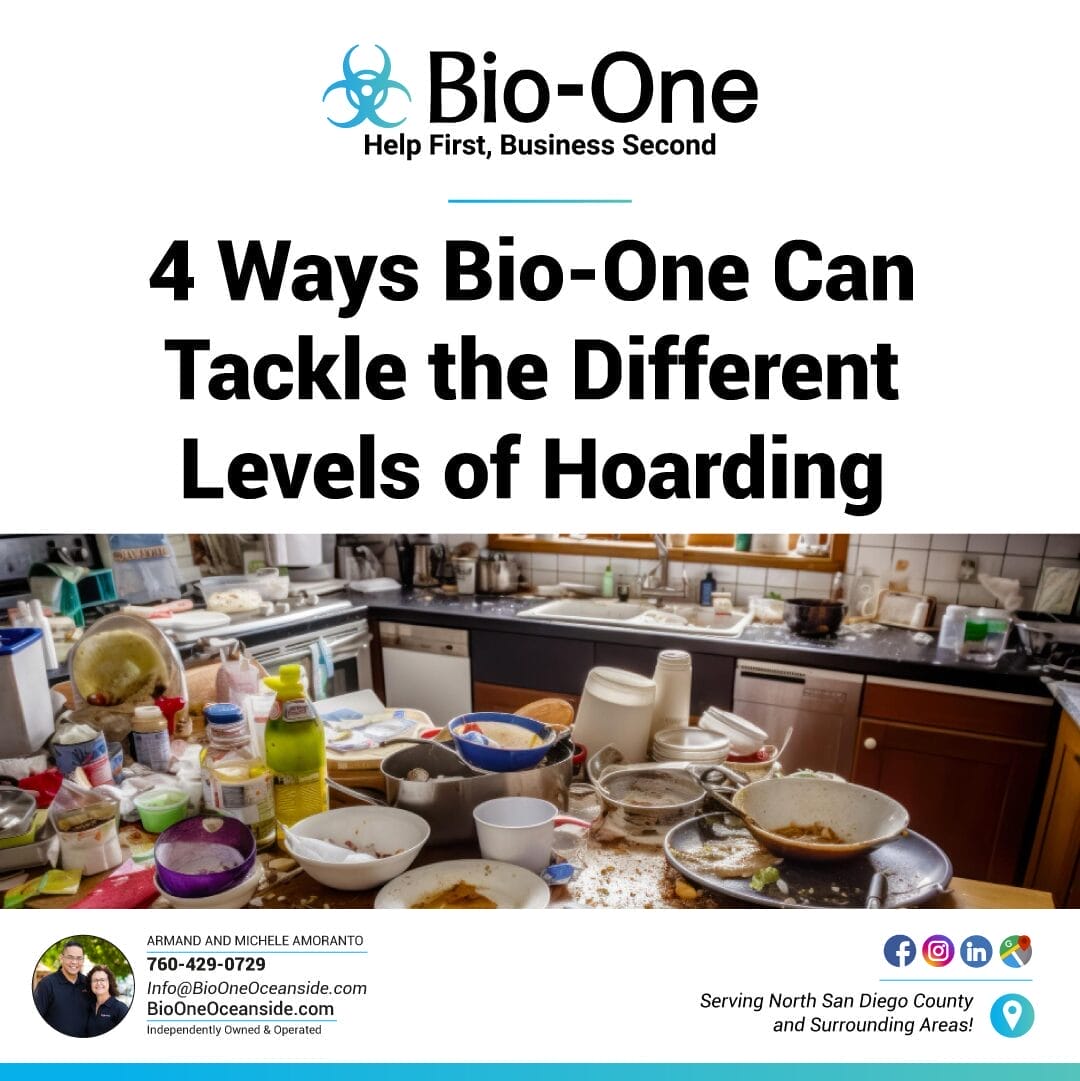
The complex issue of hoarding is a deeply personal battle, as it impacts not only the individual but also those in their immediate circle and environment. Bio-One, with its unique expertise in cleaning up after traumatic incidents, can be a support system for those struggling with hoarding. Let's deep-dive into the levels of hoarding, and how our professional services can manage and alleviate the different stages of this challenging condition.
Hoarding is more than just an excessive gathering of items; it is a mental health condition that can severely affect a person's quality of life. What begins as an attachment to certain possessions can escalate over time, transforming living spaces into hazardous environments. Understanding hoarding is the first step towards addressing it.
Hoarding is not a one-size-fits-all condition. The five levels of hoarding help identify how severe the behaviors are, with level 5 being the most critical. Here's how the levels break down:
At the initial level, the clutter is minimal and doesn't interfere with daily living or create safety hazards. There may be only one or two rooms affected, and the space can still be used for its intended purpose.

The next level sees more consistent and slightly more dense clutter. Spaces are still usable but are becoming more restrictive in their intended functionality. The house may become a source of embarrassment or isolation.
At this point, rooms become restricted and can only be used in part due to clutter. Some localized repairs might be required due to intangible distress signs like mold and odors. The individual’s relationships and living standards become more strongly affected.

This level indicates that more than half of the living space is impacted by clutter. Basic utilities may be impacted, increasing the risk of fire hazards, falling, and other health hazards. The individual experiences severe effects in daily life and may be at risk for eviction.
The most severe level involves unsanitary conditions that significantly inhibit the use of the space. Infestations, no running water, structural damage, and compromised sanitation are common. At this stage, an individual may be on the brink of losing their home or experiencing homelessness.
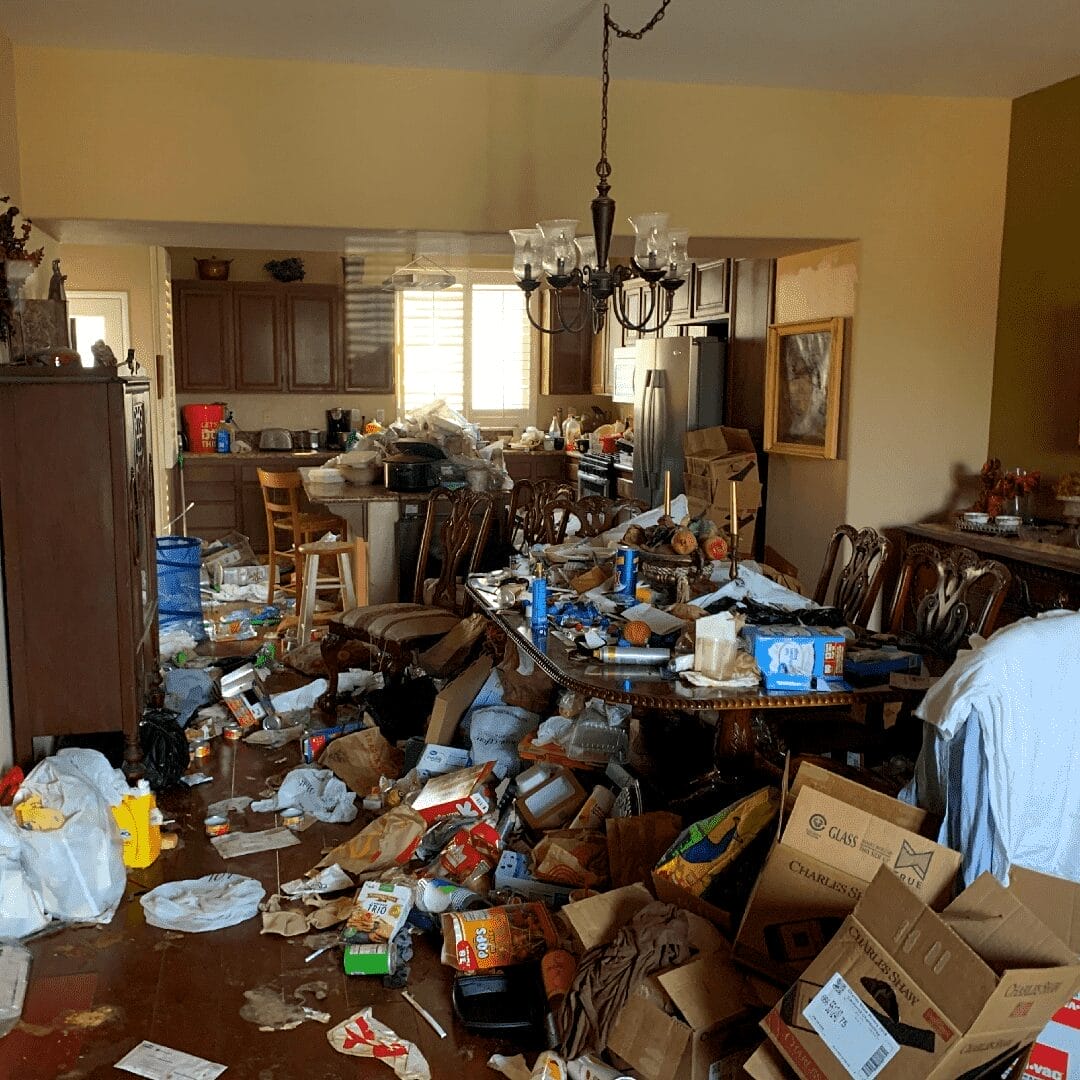
Each level requires a nuanced approach to cleanup and management, which is what makes Bio-One's customized solutions so effective in addressing this challenge.
Bio-One's approach starts with a thorough assessment of the situation. This initial step is pivotal in creating a framework for the cleanup operation. A professional assessment involves:
Bio-One's cleanup services are as much about healing as they are about physical cleanup. The specialized team works with:
The methodical approach to sorting, cleaning, and restoring order in the hoarded spaces ensures a safe and habitable living environment for the individual. We cover the basics of our hoarding cleanup process in our blog post: 4 Tips for Navigating and Safely Restoring a Hoarded Home.
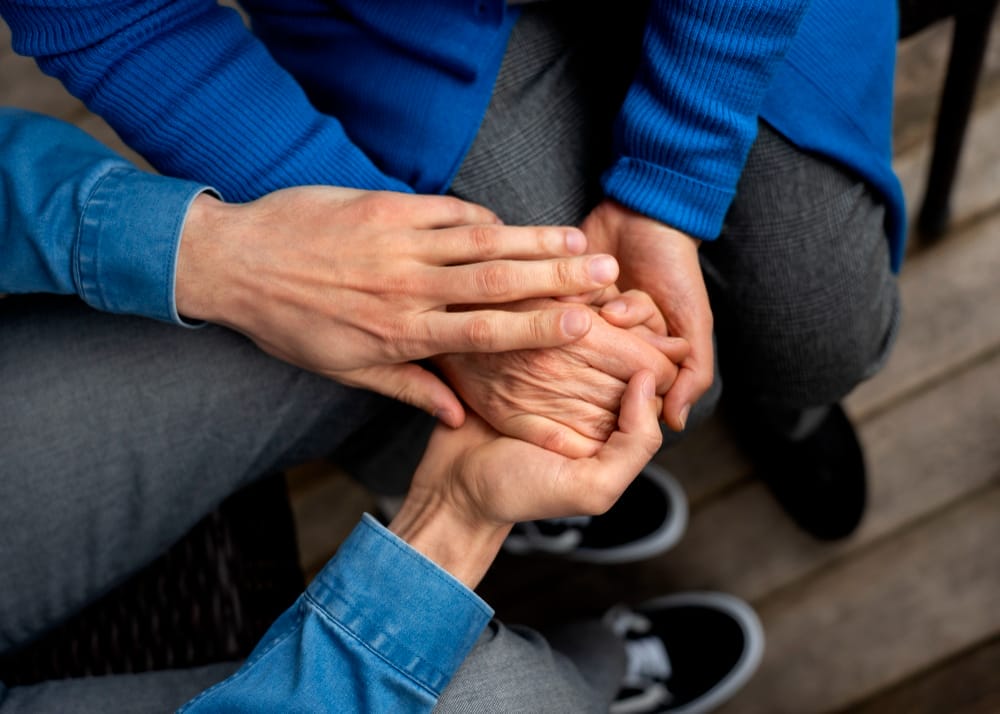
Cleaning up is only part of the solution. Hoarding disorders often require ongoing emotional and psychological support. Ongoing support means:
The emphasis on support ensures that the individual is not just abandoned after the cleanup but is continually supported on their path to recovery.
Bio-One of Oceanside can provide:
Seeking help, especially from a professional with the right experience and compassion, can lead to significant improvements for those struggling with hoarding. Remember, Bio-One’s restoration services are not just about cleaning up; we focus on establishing a supportive and structured environment for those facing hoarding challenges to live a healthy, fulfilling life. If you or someone you know needs help, do not hesitate to reach out!
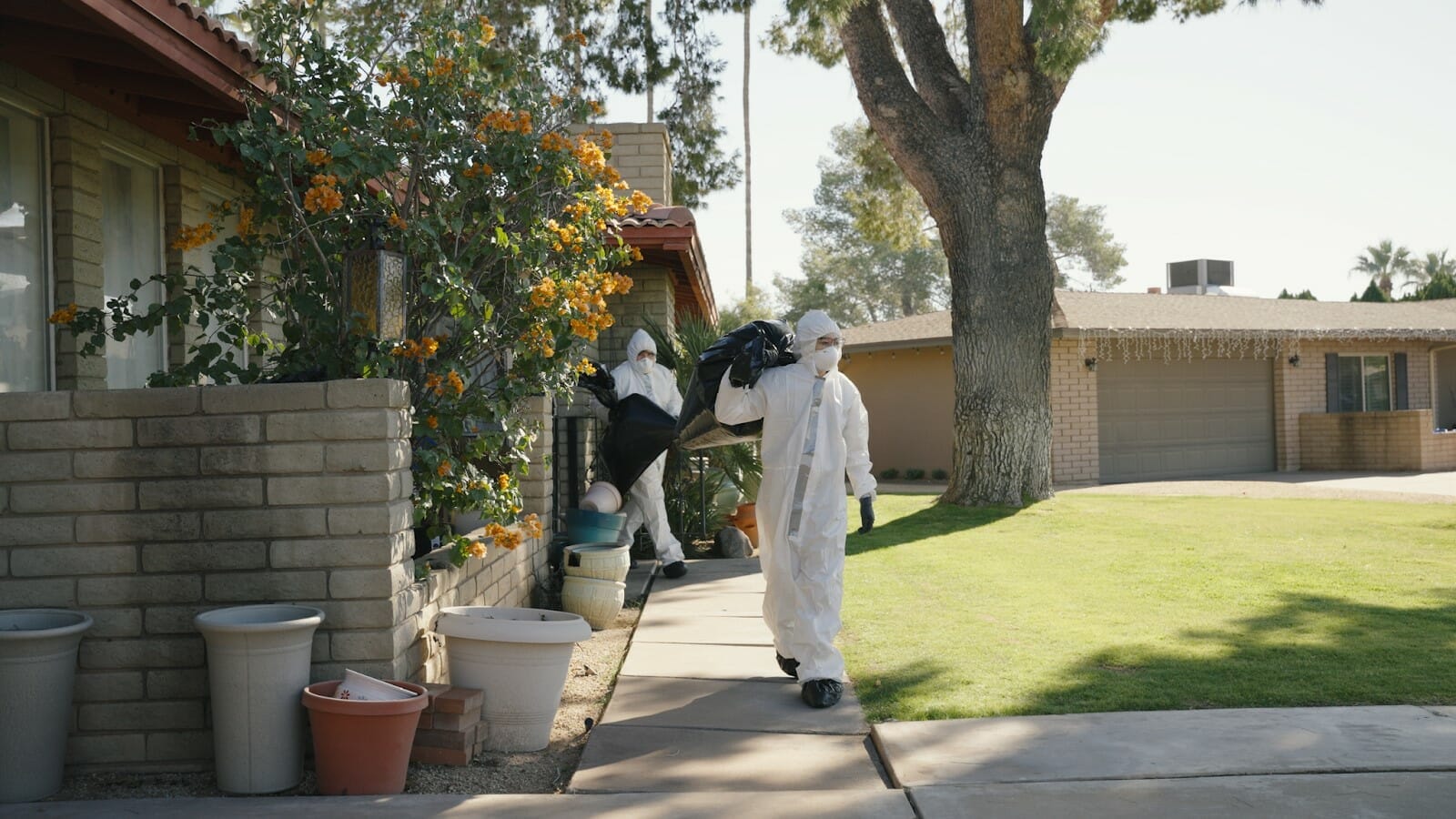
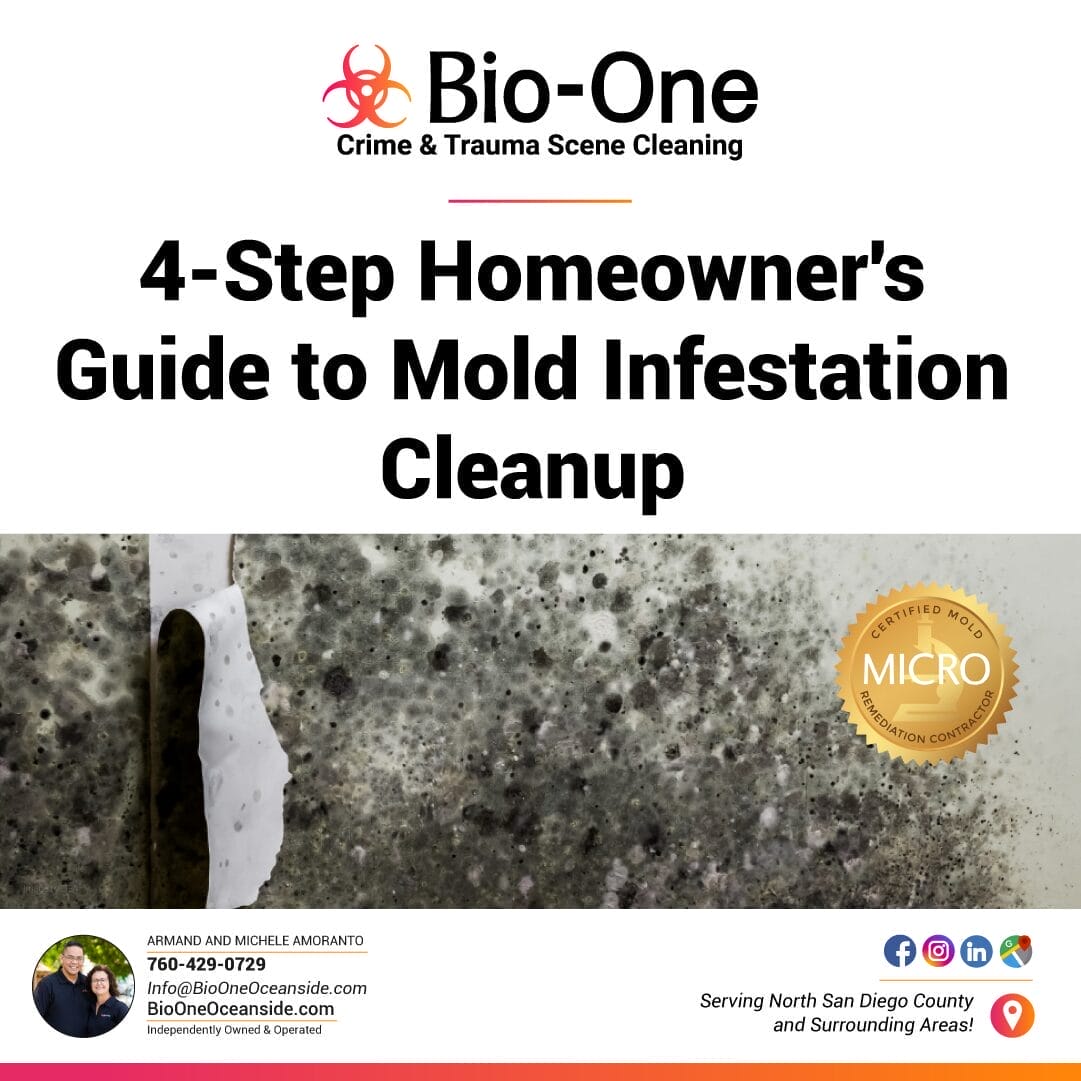
Discovering mold in your home can be alarming, but understanding how to efficiently and safely tackle the issue is crucial. This listicle outlines a methodical approach that any homeowner can employ to address a mold infestation cleanup. From identification to prevention, follow these steps to protect your home and your family from the harmful effects of mold.
Mold isn't always visible, but it often makes its presence known through various signs. Keep an eye out for:
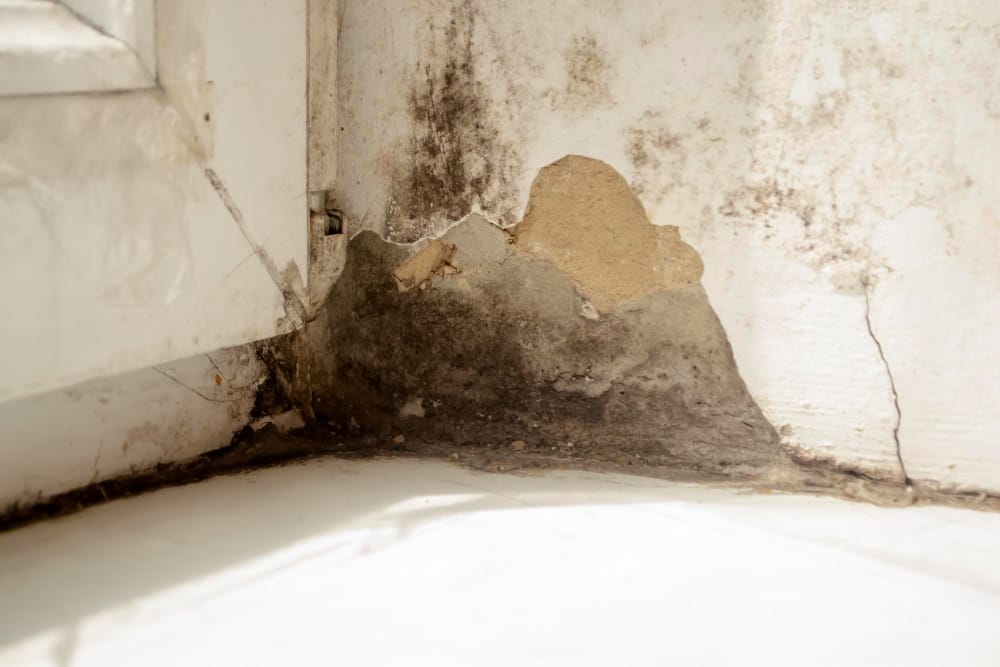
Mold thrives in damp, dark, and warm environments, common in places like:
Common indoor molds include:
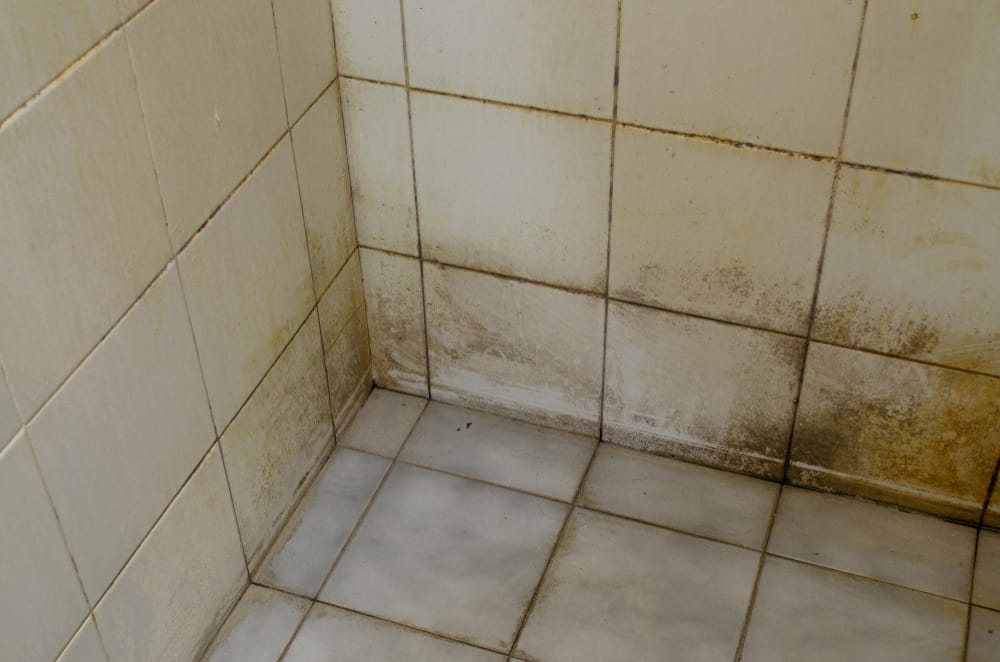
Identifying the type can aid in understanding the risk level and how to proceed with cleanup.
Before commencing any cleaning, safeguard yourself with:
Learn more about the necessary materials to clean up by visiting the EPA's official mold cleanup guide: Mold Cleanup in Your Home
It's essential to keep the affected area isolated. Use:
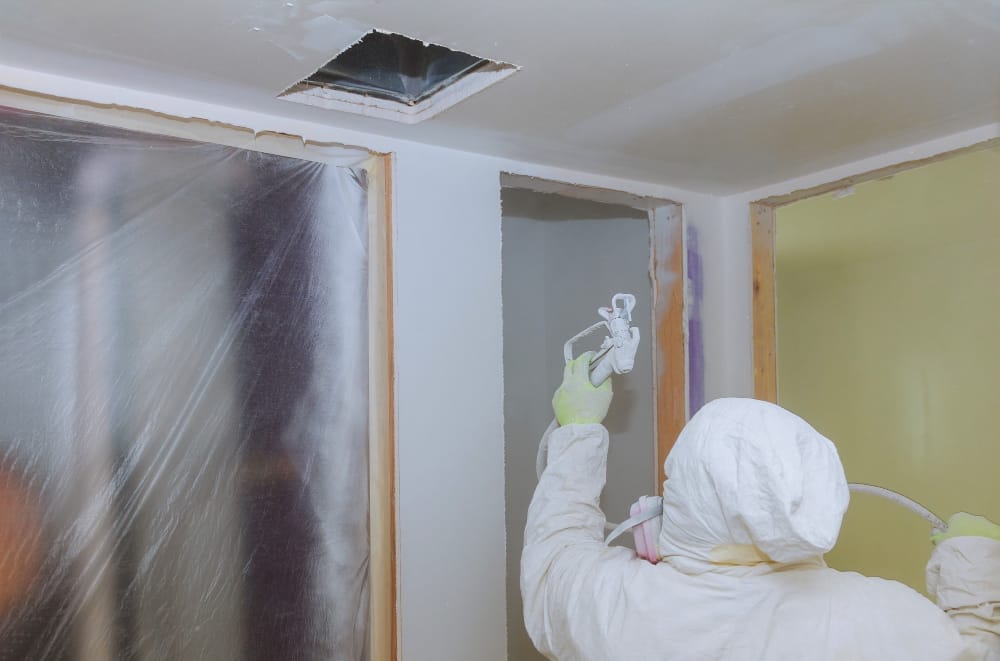
Creating a clean zone and minimizing exposure will protect you and prevent spreading. Containing a mold-infested environment is just as important as cleaning the mold itself!
Gather the following:
Always work from the least contaminated area to the most contaminated, and follow these steps:
Remember to dry the space completely after cleaning, as mold requires moisture to grow.
If your infestation is extensive, or if you're dealing with toxic mold, it's best to hire a professional service. They have the expertise and equipment to handle severe cases, ensuring it's done right the first time.
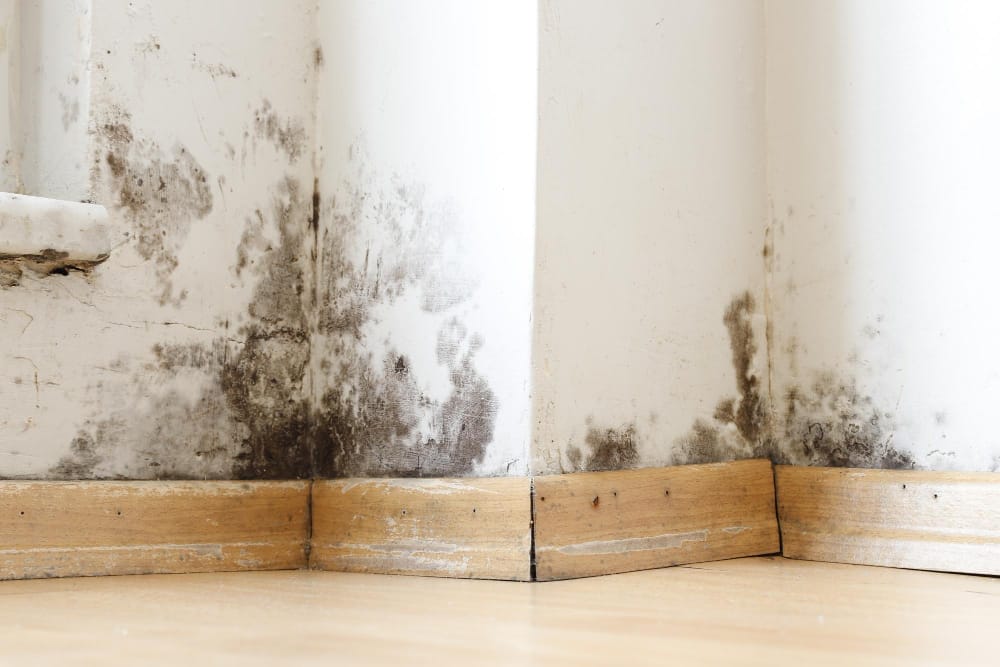
The best way to prevent mold is to control moisture:
Must read: Tips for Keeping Homes Free of Mold & How Bio-One Can Help
Frequent checks of potential mold-prone areas will allow you to catch issues early:
Regular inspections and swift maintenance will keep your home mold-free.
Mold infestations are not to be taken lightly. Prompt action is necessary to negate the health risks and structural damage they can cause. By understanding the type of mold, taking safety precautions, following the correct cleaning process, and implementing preventive measures, you can effectively manage the situation. Stay informed and diligent, and remember, for a professional and thorough remediation, Bio-One of Oceanside is ready to assist.
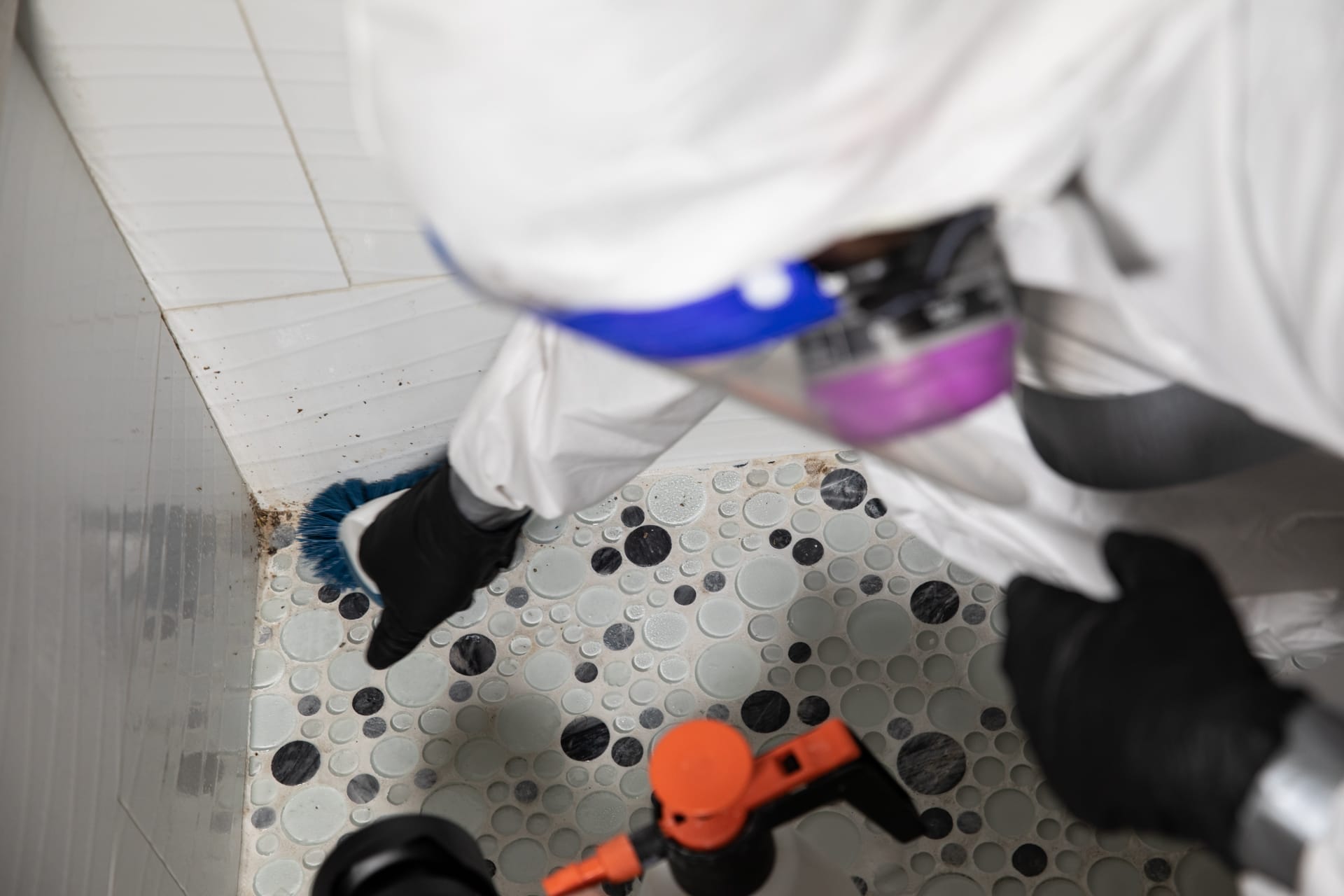
Bio-One of Oceanside offers mold cleanup and water damage restoration services in the North San Diego County Area and the Southern Orange County Area with our second office Bio-One of South OC!
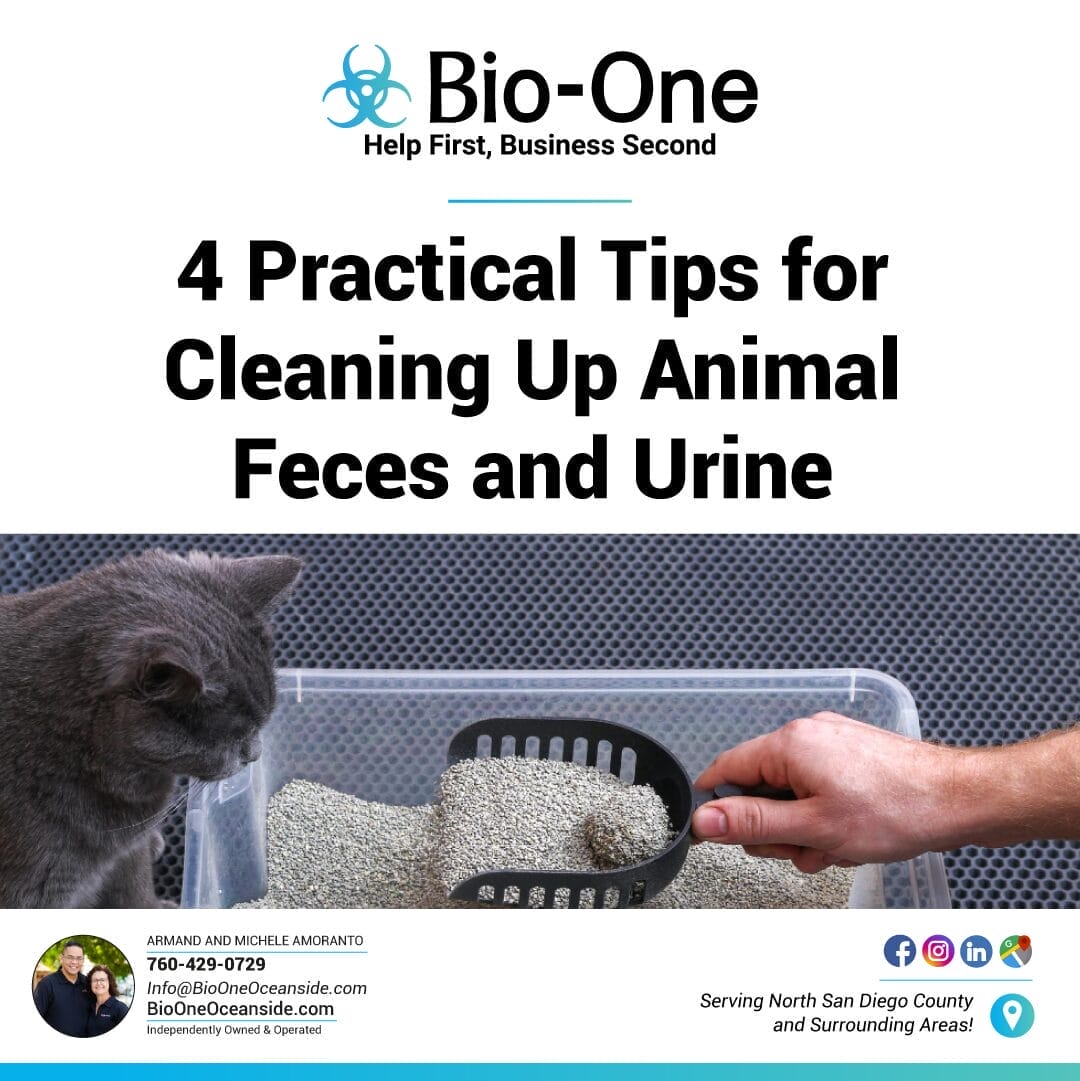
Every pet owner and animal caretaker knows cleaning up animal feces and urine is an inevitable chore. Whether you're dealing with surprise indoor accidents or need to maintain a welcoming and hygienic space for humans and animals, a good cleanup routine is essential! This guide will equip you with practical and effective strategies to handle pet waste and maintain a clean, healthy environment.
The first step in tackling an animal waste cleanup is to gather the right tools. The following are essential, so be sure to checkmark all of them!
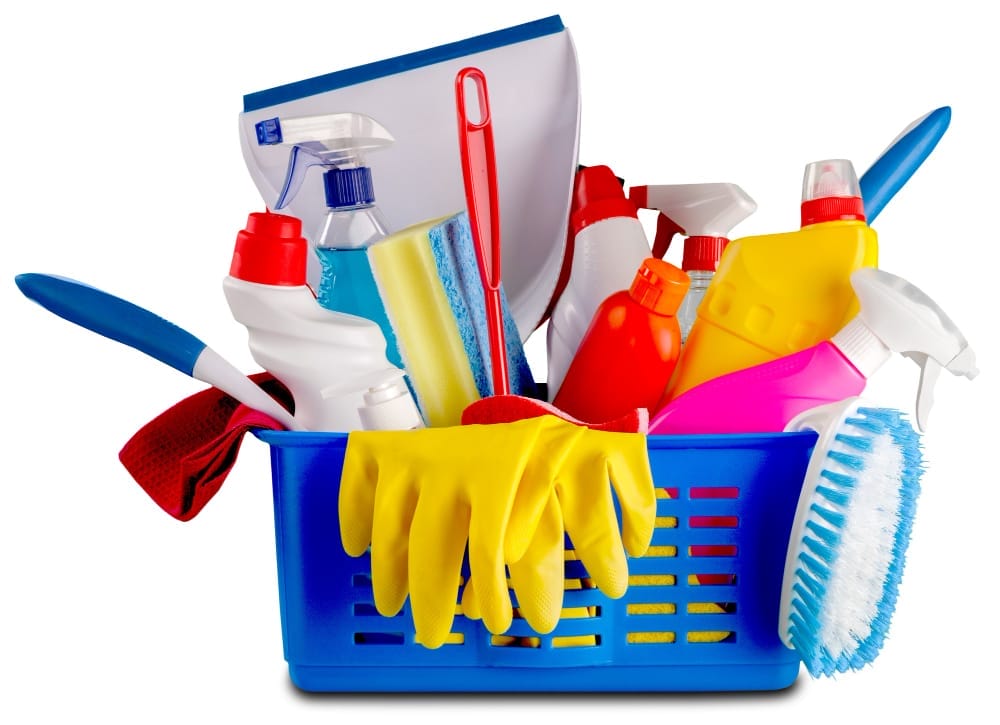
Harsh chemicals can pose health risks to animals, especially those known to lick surfaces. Look for eco-friendly, non-toxic cleaning solutions that don’t contain ammonia, which can be especially harmful to pets. When in doubt, opt for products designed specifically for pet cleanup, which often include enzymes that break down organic matter without posing health risks.
Here is a guide for choosing pet-safe products: Your Guide To Pet-Friendly Spring Cleaning
Dealing with solid animal waste involves more than just picking it up. Here are the steps to do it right:
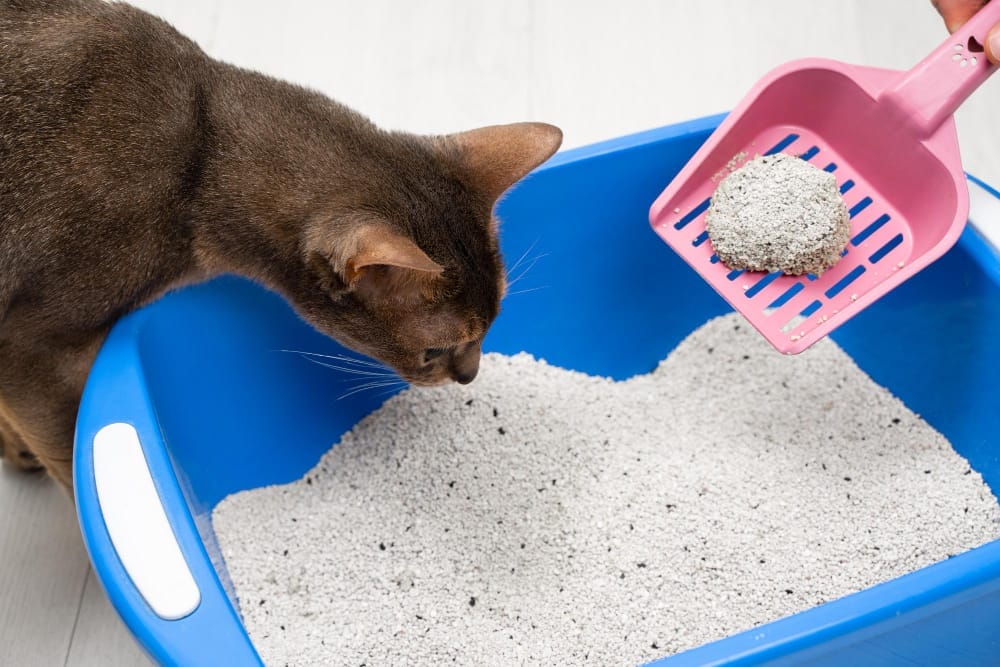
Solid waste can contain harmful bacteria that spread easily. Be sure to keep pets away from the cleanup area and any contaminated cleaning tools. Clean and disinfect items like the dustpan and scrub brush after use.
Urine can leave stubborn stains and odors. It's important to eliminate both to prevent repeat accidents:
Persistent odors can signal to your pet that a spot is an acceptable bathroom. To neutralize odors:

Once you've addressed visible waste and odors, it's time for a deep clean and disinfection:
Deep cleaning is much more thorough than a regular cleanup, and it may involve materials and equipment that are not typically used. If it's within your budget, hire a deep cleaning company for help!
Always immediately clean up animal feces and urine, gather the appropriate tools, and use safety gear. Address solid waste, deal with urine with a method to remove and neutralize odors, and ensure deep disinfection. Following these steps will not only maintain cleanliness but also contribute to the health and well-being of your beloved pets and your household.
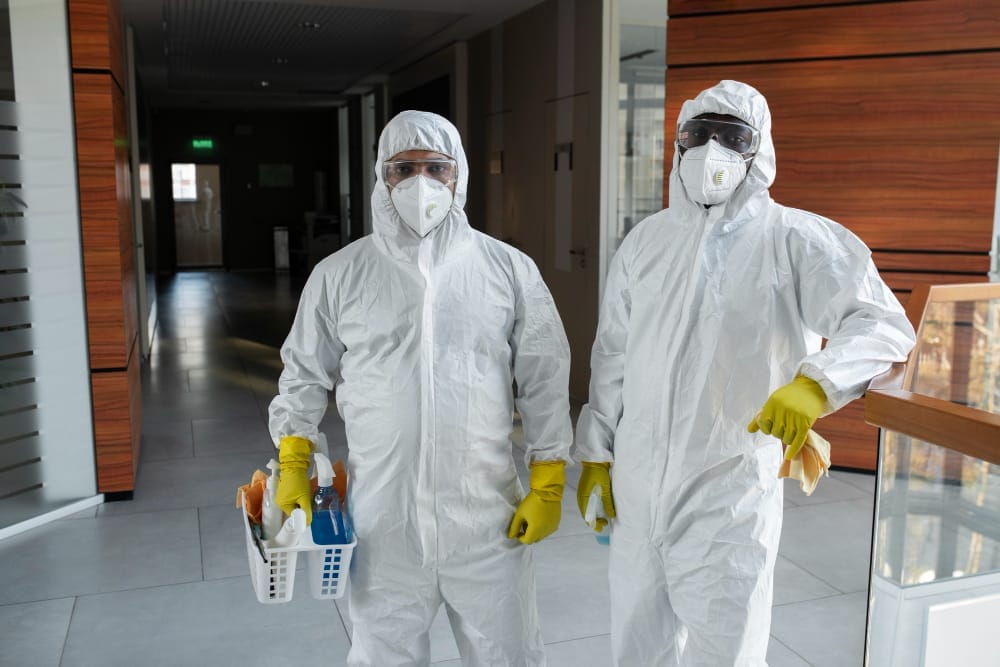
Maintain a consistent and vigilant cleaning routine, and always be mindful of the products you’re using. A little effort now can save you a lot of stress and potential health issues down the line. Invest in your space and the creatures that make it home, and enjoy the peace of mind that comes with a sanitized and serene environment.
Bio-One of Oceanside is a reliable partner for feces and urine cleanup services, utilizing industry-grade equipment and pet-safe methodologies. If you need professional assistance, reach out for a thorough and discreet service you can rely on!
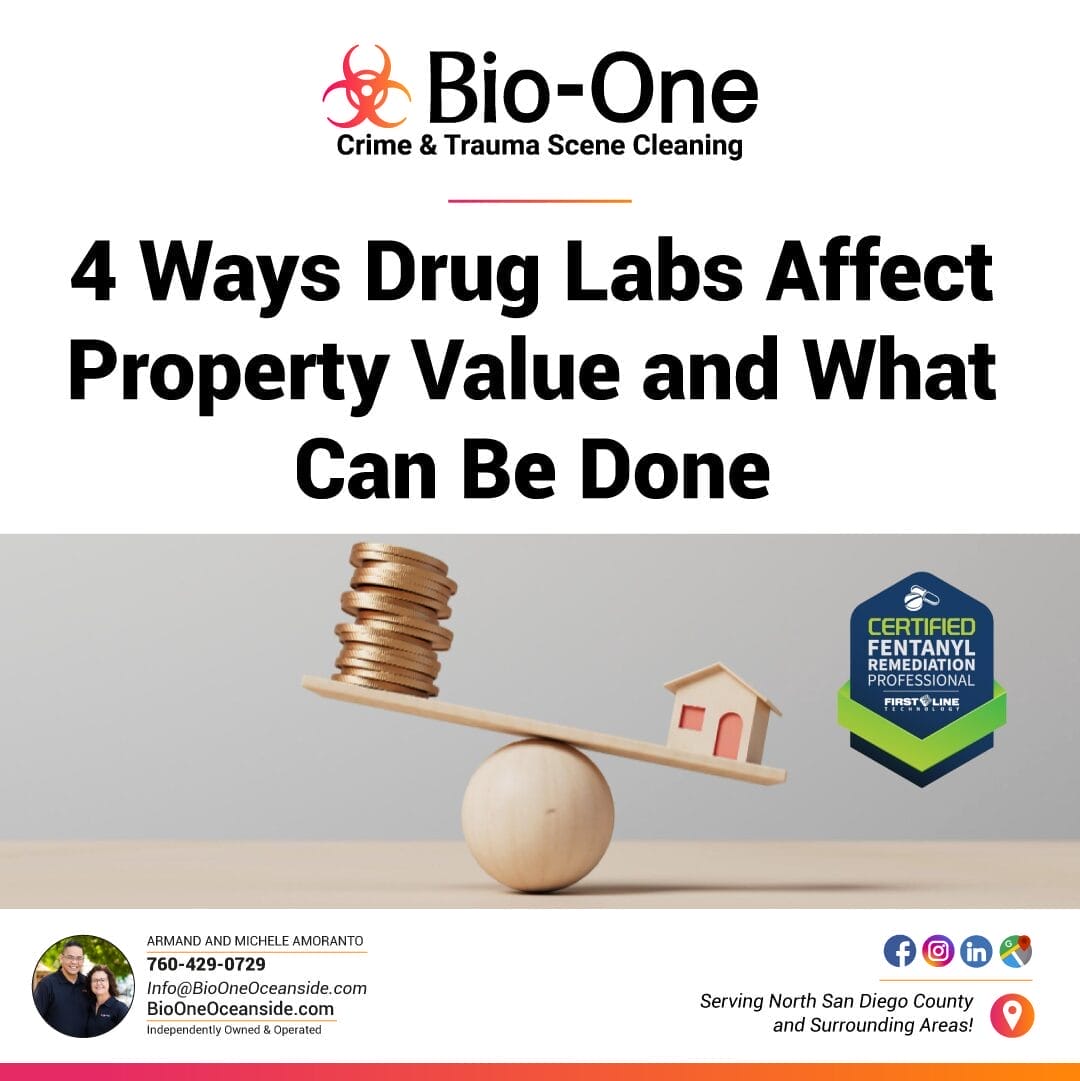
The discovery of a drug lab on a property is more than a mere inconvenience; it can be catastrophic for the property's value and the well-being of those who dwell within it. In the eyes of realtors, investors, and homeowners, a drug lab is a lurking shadow that darkens the corner of their investment and their future. But why is this shadow so daunting, and what can be done to dispel it? Take a look at 4 ways drug labs can affect the value of your home or property and how our drug lab decontamination specialists at Bio-One of Oceanside can help.
The presence of a drug lab in or near a home can be a scenario straight out of a nightmare. Drug production involves hazardous chemicals, some of which are highly volatile. Methamphetamine and similar substance labs are notorious for leaving behind a toxic residue that lingers in the environment long after production ceases. This residue poses serious health risks, and the chemicals used can pollute the air, water, and soil, causing greater environmental contamination.
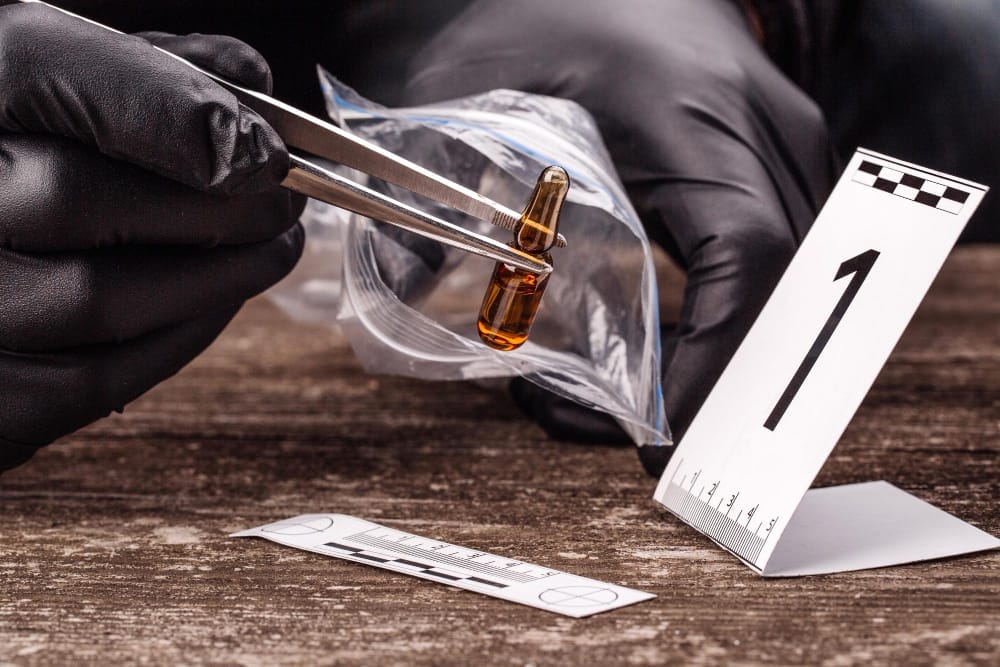
The reputation of a property can greatly influence its marketability. A history of a drug lab in a property’s past can also skew people's perception of value. The stigma is often insurmountable, leading to reduced desirability among potential buyers and tenants. It's a black mark on the property's record that's hard to erase, and it can drive down property values in the area.
Family homes and investment properties alike face the fallout of drug lab discoveries. Legal implications can include property seizure if drug activity is linked to criminal investigations. But even in the absence of seizure, the aftermath can be fiscally punishing. The property may require extensive remediation that demands sizable financial investments. Moreover, the taint of a drug lab on a property makes obtaining insurance and financing a Herculean task. Lenders and insurers perceive such properties as high-risk, further complicating any transaction or renovation efforts.

Learn more about this topic by visiting the National Association of Realtors ®: Land Use & Property Rights > Hazards & Disclosures > Meth Labs
Remediation is not just a matter of cleanliness; it's a matter of safety and legal compliance. Addressing a drug lab's impact involves a careful and comprehensive process, often best left to professionals. From the removal of hazardous materials to the restoration of the property, the correct remediation path can be complex. It involves testing, removal, encapsulation, and verification, ensuring that a property is not only clean but also certified as contamination-free.
Benefiting the property value and the peace of mind of those involved, professional cleaning services like Bio-One specialize in the decontamination of drug-lab-affected properties. With expertise in meth lab cleanup, fentanyl remediation, and drug cleanup services, companies like ours at Bio-One offer a beacon of hope in the face of this potentially disheartening situation. Our services go beyond mere cleaning; we are structured to mitigate risk, restore safety, and recover property value.
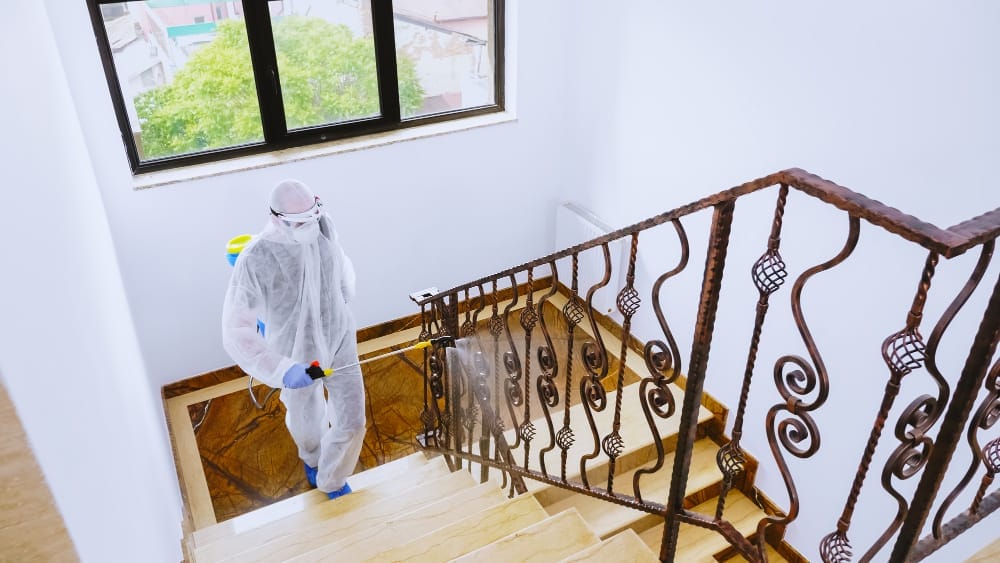
With swift and decisive action, it is possible to regain control and restore the vitality of the property. This restoration is not only a financial imperative but also a moral one. For homeowners, realtors, and investors facing a crisis like a drug lab on their property, there is hope.
For those in North San Diego County and Southern Orange County, the resource to bridge this distressing gap is Bio-One. Our expertise in the domain of drug lab remediation is a lifeline for those beleaguered by the aftermath of drug lab discoveries. With safety as our core promise and remediation as our primary mission, we offer a thorough solution to an otherwise devastating scenario. Contact us for a free consultation!
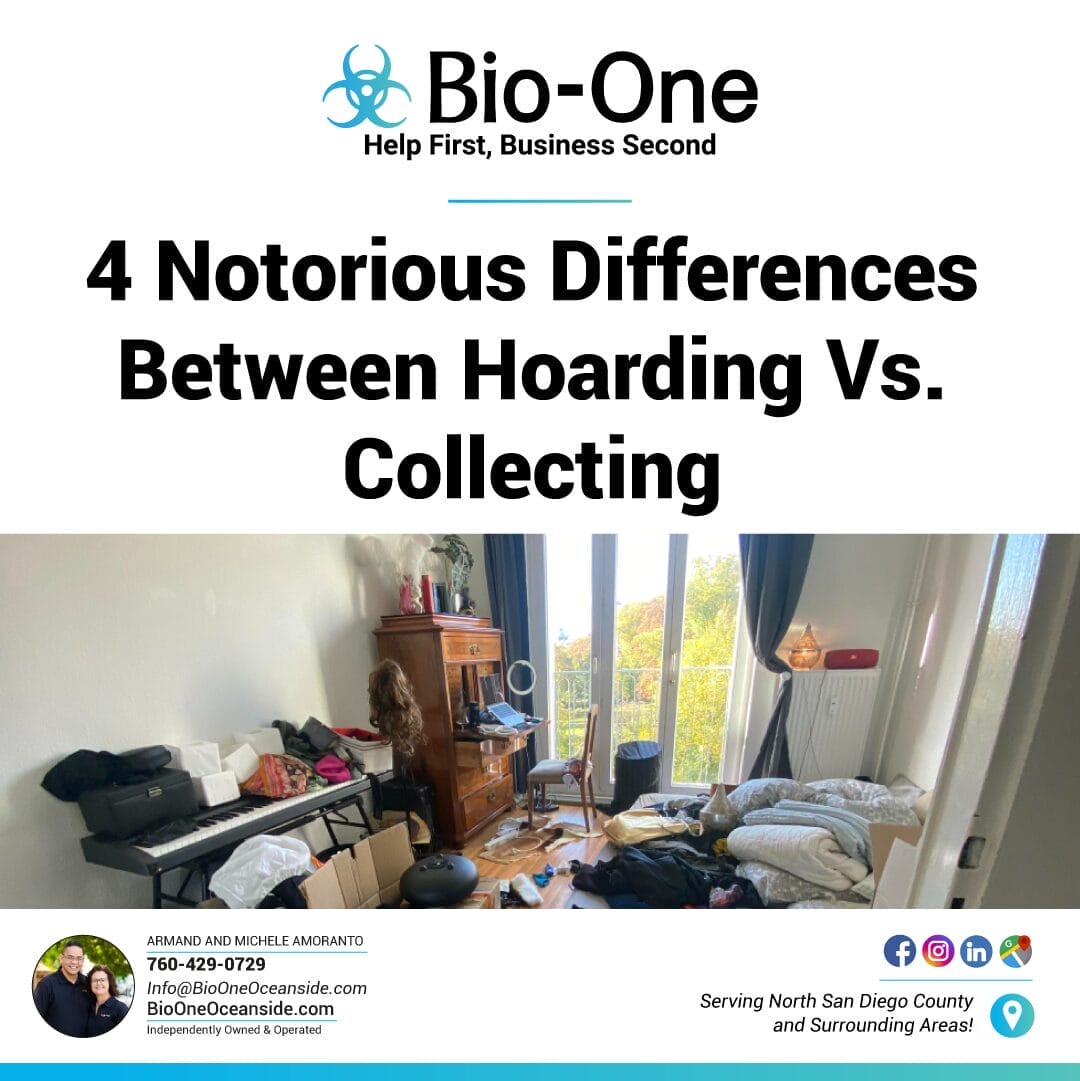
For most people, curating a collection of rare stamps, vintage vinyl records, or stunning artwork might seem like a hobby, a passion - perhaps a smart investment. Similarly, the term 'hoarding' can evoke images of reality TV shows piled high with newspapers or empty jars, often without a clear understanding of the underlying condition. But in the spectrum of human behavior, collecting and hoarding represent two psychological states at polar ends, with distinctions that go beyond mere appearances.
Understanding these differences is not only academically beneficial but also greatly significant when supporting individuals struggling with either behavior. Let's delve into these critical distinctions between hoarding vs. collecting.
The motivation behind hoarding is complex and often stems from deep-seated anxieties. For the hoarder, each item saved represents a potential utility or averted waste, with decisions often driven by a profound sense of responsibility and the need to prevent discomfort or future crises through preparedness.
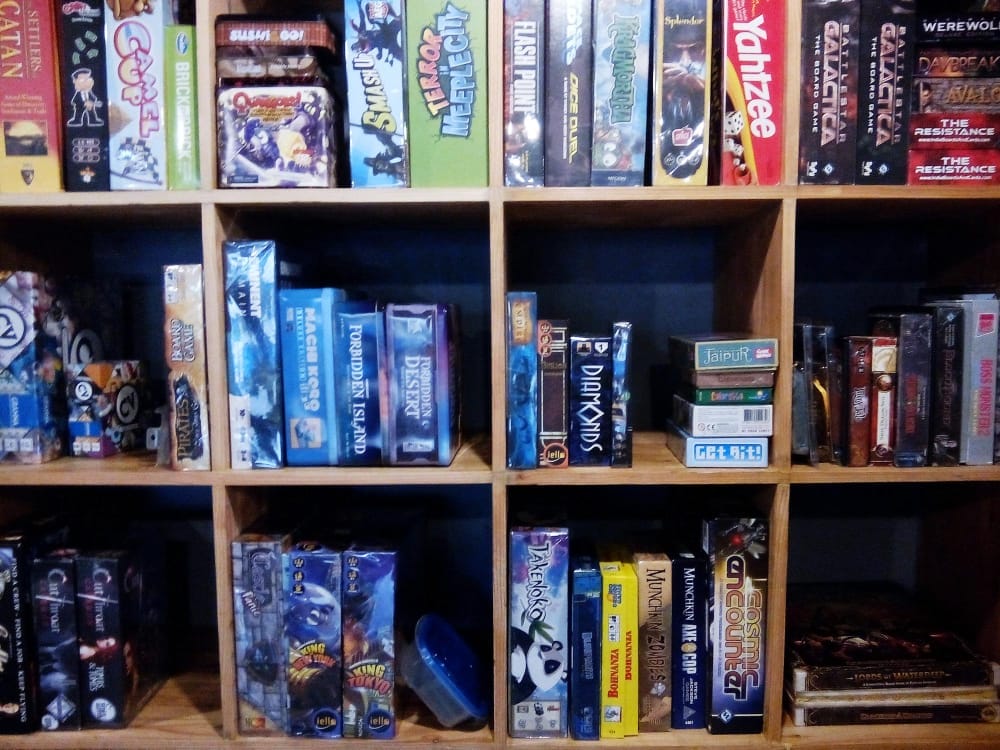
Collecting, on the other hand, is typically a leisurely, purposeful activity fueled by the enjoyment of acquiring and owning items. This act is characterized by intentionality and the pursuit of specific items that hold personal or investment value. The collector takes joy in the hunt, the community with fellow enthusiasts, and the pride in their assembled collection.
Clutter, a natural byproduct of hoarding, extends beyond aesthetics, as it can impede functionality and create numerous health and safety hazards including mold, rodent infestations, and fire hazards.
By their very nature, collectors organize. They often display or store their items meticulously, allowing for immediate appreciation. Spaces are arranged with purpose, and there is a method to the maintenance of the collection, whether cataloged, labeled, or neatly arranged per their collector's preference, which contrasts sharply with the disarray commonly associated with hoarding.
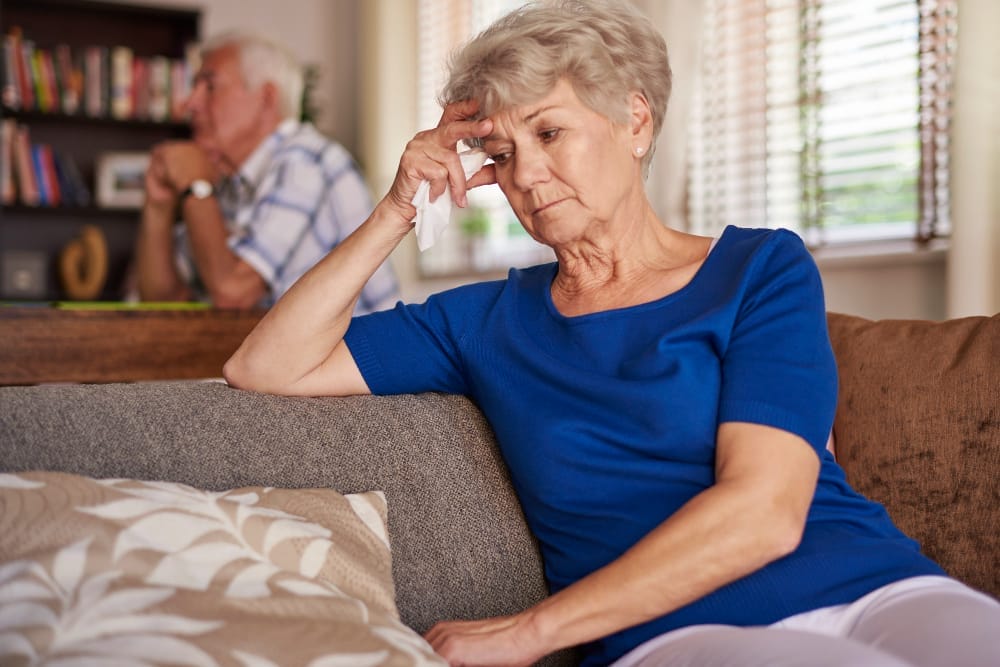
One of the main differences in hoarding vs. collecting scenarios is that every saved item carries emotional weight, whether it's a sentimental attachment or a belief in the item's potential utility. The difficulty in discarding items can often be linked to an underlying trauma or loss, wherein the item becomes a psychological barrier and shield against future harm or loss.
Collectors also form strong emotional attachments to their items. However, they maintain a sense of hierarchy within their collection. People often trade, sell, or give away duplicates or items they perceive as no longer valuable, showing a pragmatic approach to their emotional investments. This behavior sharply contrasts with hoarders' typical reluctance to part with any possessions.
Hoarding can have severely detrimental effects on an individual's mental health, home life, and social well-being. The compulsion often isolates the hoarder, as embarrassment or a refusal to let others see the home's state leads to reduced social interactions and possible neglect of personal health and maintenance.
Collecting tends to have the opposite effect, often serving as a boon to the collector's mental health. The pursuit is a social activity that fosters connections with others who share the same interests and can contribute significantly to a person's sense of identity and purpose. The act of collecting can provide sustained satisfaction and pride that enhances the overall quality of life.

Instead of approaching hoarding with misunderstanding and judgment, recognizing it as a psychological condition is the first step in offering the appropriate help and resources to those in need.
In the case of hoarding, professional assistance is often necessary for the affected individual's safety and well-being. Bio-One Oceanside specializes in the delicate yet vital service of hoarding cleanup, approaching each situation with the necessary care, discretion, and expertise to restore homes and help individuals move forward toward a more functional, supported life.
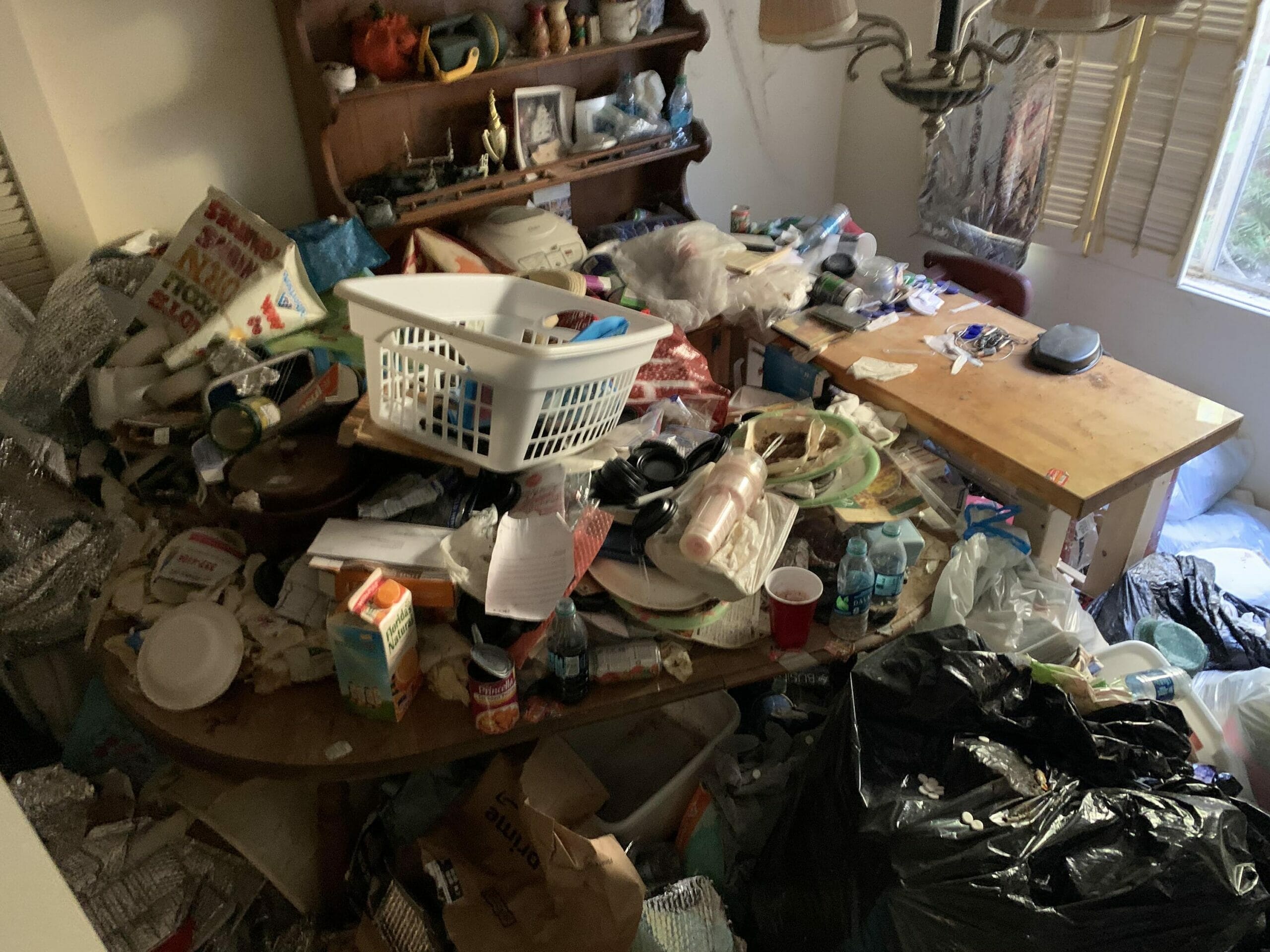
Shedding light on the differences between hoarding vs. collecting is a step closer to a compassionate and inclusive community. Hoarding is not meant to be an exclusionary term, but rather a call to intervention!
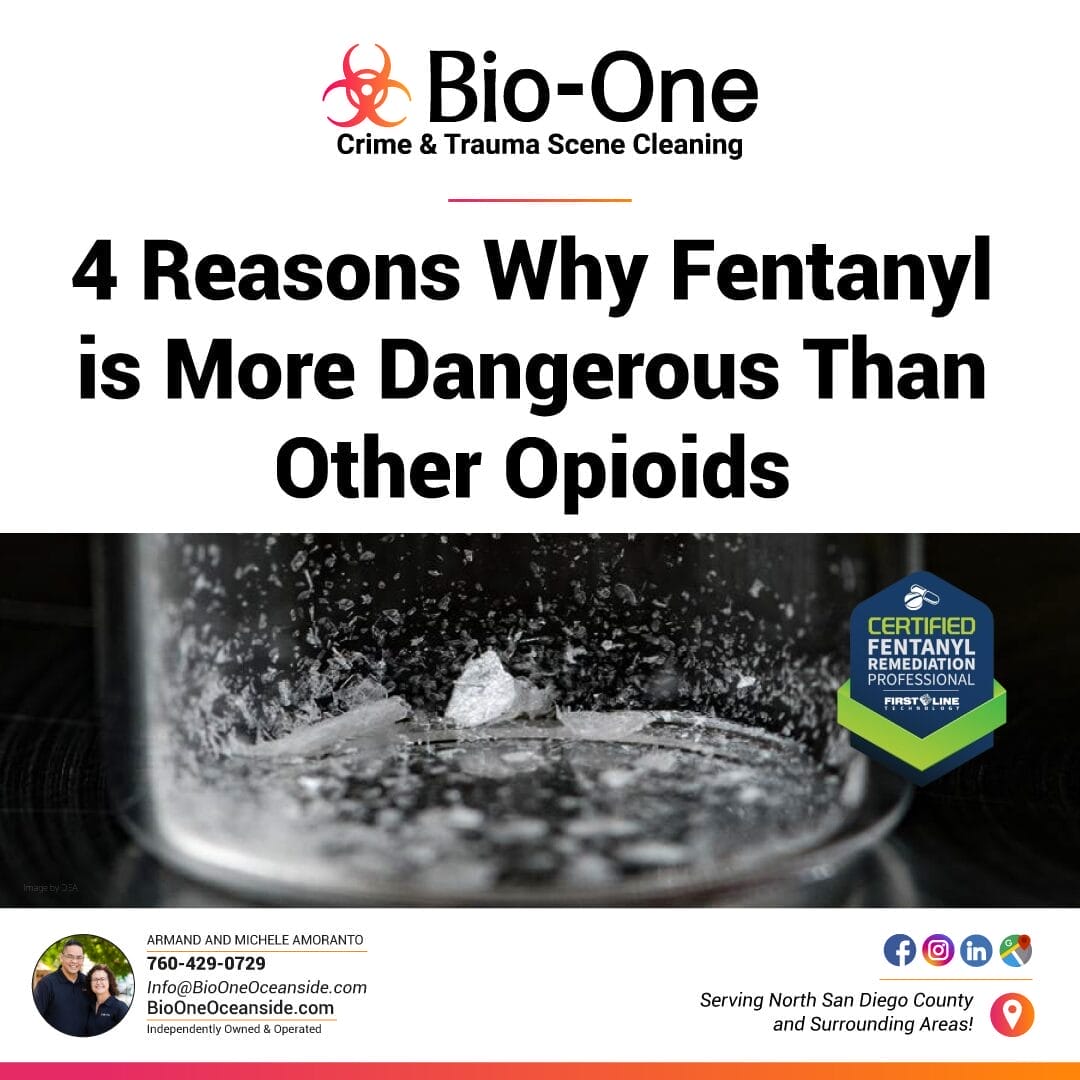
The opioid crisis continues to devastate communities across the globe, but within this complex issue, one substance stands out as particularly lethal: fentanyl. As public health advocates, substance abuse professionals, community leaders, or even homeowners or heads of household, understanding why fentanyl is more dangerous than other opioids is crucial in combatting this epidemic.
The fentanyl epidemic has become one of the most pressing public health challenges of our time. In 2020, over 91,000 people died from a drug overdose in the United States, and an astonishing 76% of those deaths involved an opioid. Within this staggering statistic, the prevalence of fentanyl—a synthetically manufactured opioid that is 50 to 100 times more potent than morphine—cannot be overlooked.
It is not just a public health issue; it's a crisis that demands focused attention and multifaceted solutions. In this article, we'll explore four key reasons why fentanyl is proving to be more dangerous than other opioids, offering insights that your community or your family can leverage to better understand and address this growing threat.
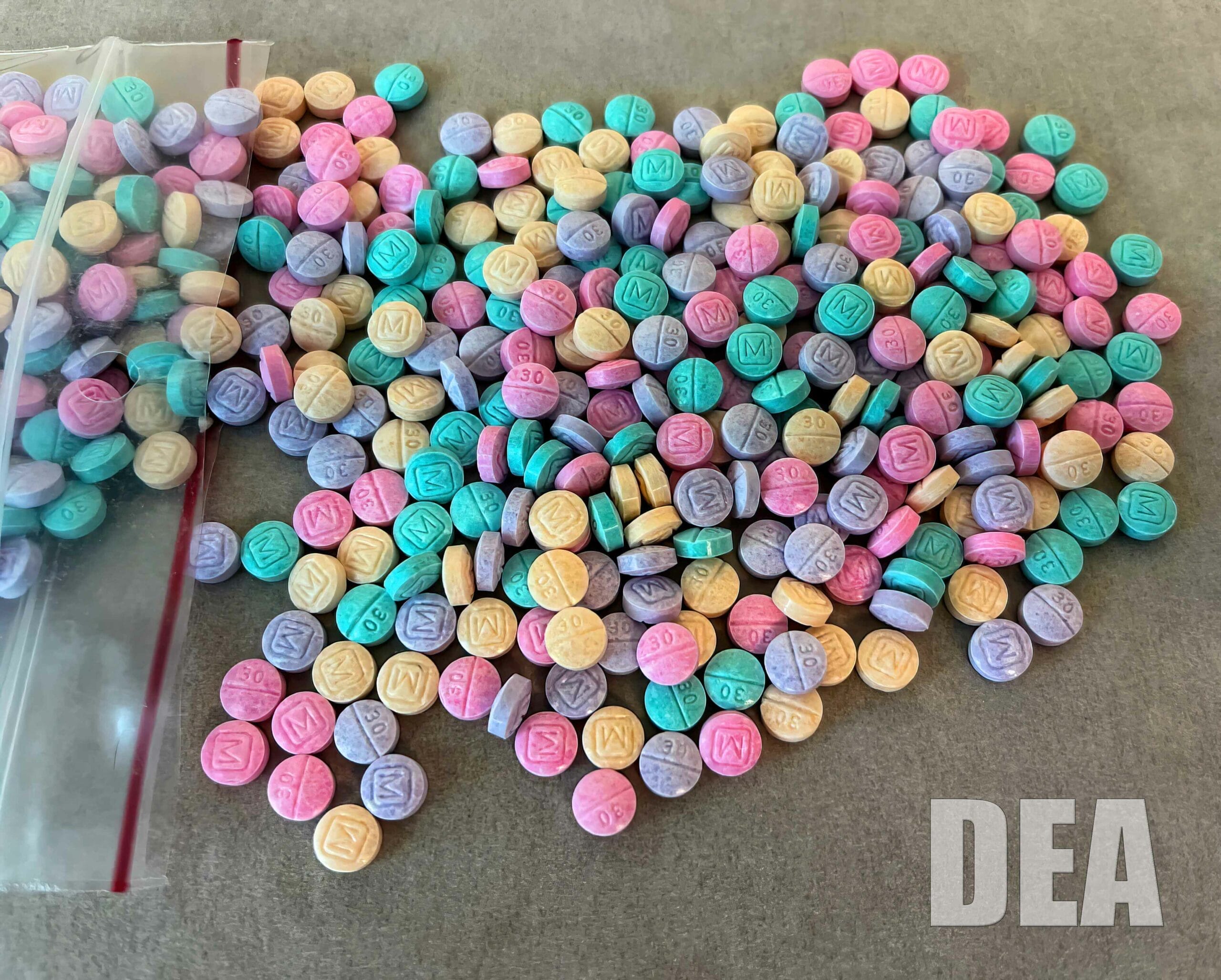
Fentanyl's potency is the primary factor that distinguishes it from other opioids. Originally developed to treat severe pain in cancer patients, Fentanyl is a synthetic opioid. However, its introduction to the illegal drug market has created a potent and deadly substance.
To contextualize fentanyl's strength, it's important to understand its potency. When we compare dosages, it takes significantly less fentanyl than heroin or morphine to elicit the same analgesic response. People who are accustomed to other opioids can easily overdose on fentanyl if it enters their systems without their knowledge.
The high potency of fentanyl contributes directly to the heightened risk of overdose. Users may not be aware that their "regular" dosage of a different opioid now contains a potent fentanyl dose, leading to respiratory failure, a common cause of opioid overdoses. Manufacturers and dealers often mix fentanyl into other drugs, such as heroin and cocaine, to increase potency and induce a more intense—and lethal—high.
Related news: 4 Fentanyl Exposure Symptoms & How to Stay Safe
The second reason fentanyl is so dangerous is its availability on the market. Fentanyl is not only potent; it is also widespread, making it far easier for people to come into contact with this dangerous drug.
Over the past decade, the fentanyl epidemic has skyrocketed. This is due in part to fentanyl's low production costs for manufacturers. These economic incentives, unfortunately, have led to a flood of fentanyl in illegal drug markets, leading to an increase in overdose deaths.
The availability of fentanyl, especially in its undiluted form, has had a staggering impact on overdose rates. Public health officials have seen a notable spike in fatalities where fentanyl has been detected, suggesting that overdoses linked to fentanyl are often more severe and less likely to be successfully reversed with naloxone, the overdose antidote.
Fentanyl's illegitimate production is the third danger area. Manufacturers often produce the drug illicitly in unregulated environments, leading to its inconsistent potency and quality, which increases its danger. The manufacturing processes are often uncontrolled, causing variations in drug purity and potency. These inconsistencies mean that individuals who use fentanyl have little idea of the strength of the dose they are taking, which significantly increases the risk of overdose.
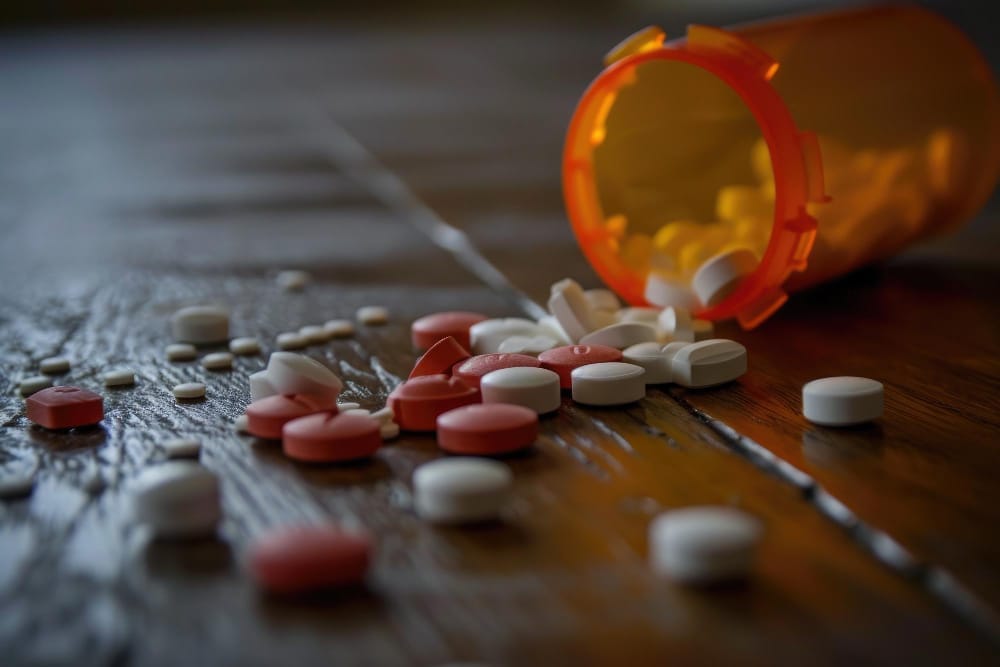
Manufacturers often produce fentanyl in one country and traffic it to many others due to its potency and ease of manufacturing, which contributes to its status as a global problem. This international underground market makes it difficult to regulate or control, further complicating prevention strategies and law enforcement efforts.
The tendency of fentanyl to mix with other substances, especially those known for their overdose risks, amplifies the complexity and hazards associated with the drug.
Drug dealers and traffickers "cut" other drugs with fentanyl to increase profits and potency. This means that substances such as heroin or cocaine may contain varying amounts of fentanyl, which can be lethal for unsuspecting users. This adulteration increases the unpredictability and danger of these drugs, leading to higher chances of accidental overdose.
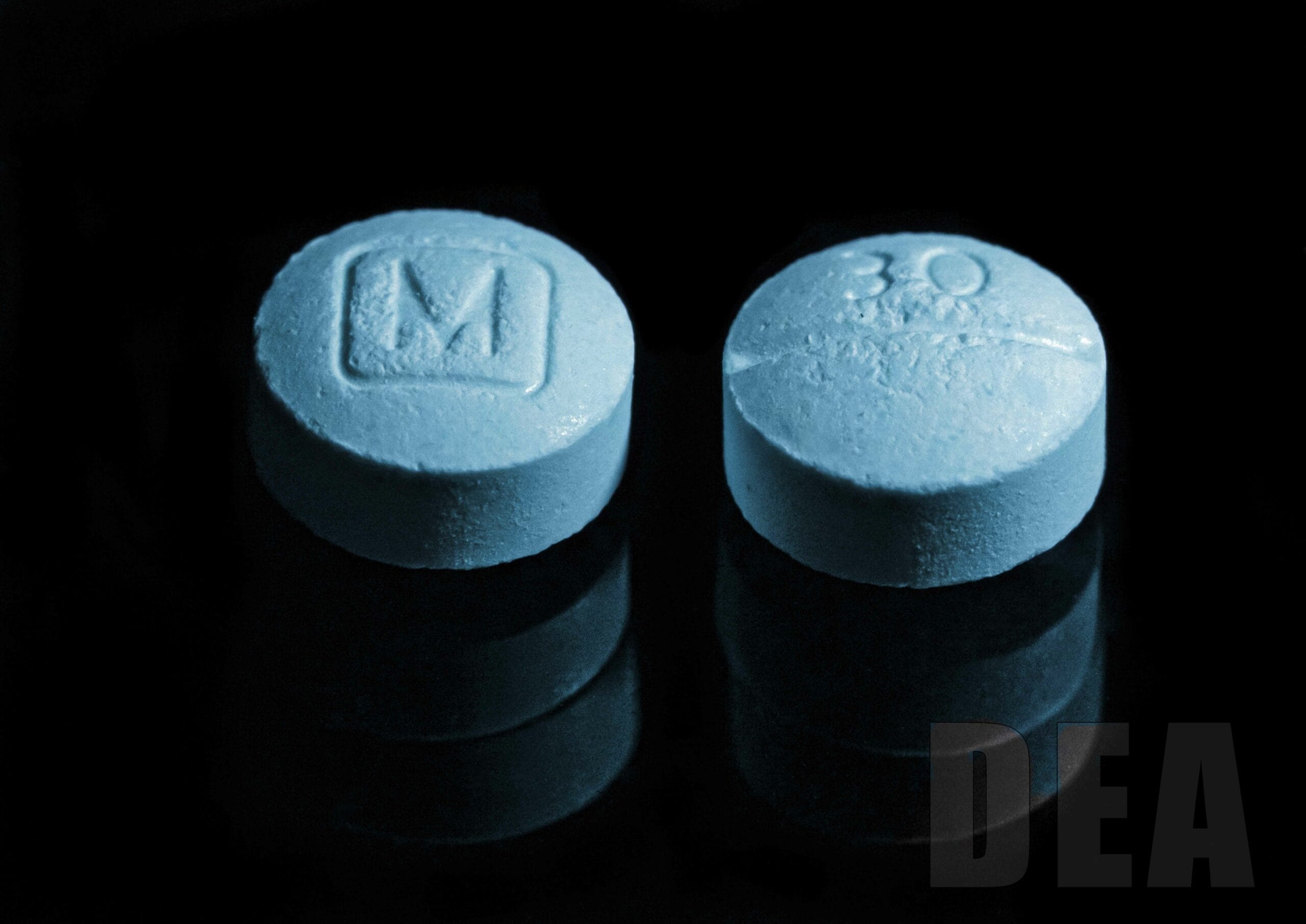
As drugs are rarely mixed homogeneously, the inconsistent mixing process typically results in one portion being significantly more potent than another. This lack of uniformity makes it next to impossible for users to gauge safe dosages, and any small miscalculation can have fatal consequences.

The fentanyl epidemic requires a collaborative and innovative approach. Engage with local initiatives, support evidence-based interventions, and advocate for broader access to resources that can make a difference. Your contribution, no matter how small, can ripple effect on the protection and well-being of communities at risk.
If you or someone you know is struggling with opioid addiction, seek help without delay. Bio-One of Oceanside offers professional fentanyl remediation services, as well as biohazard remediation and disinfection. Our compassionate team is available 24/7 to assist with any crisis, providing support and resources to help individuals and families in these unexpected emergencies.
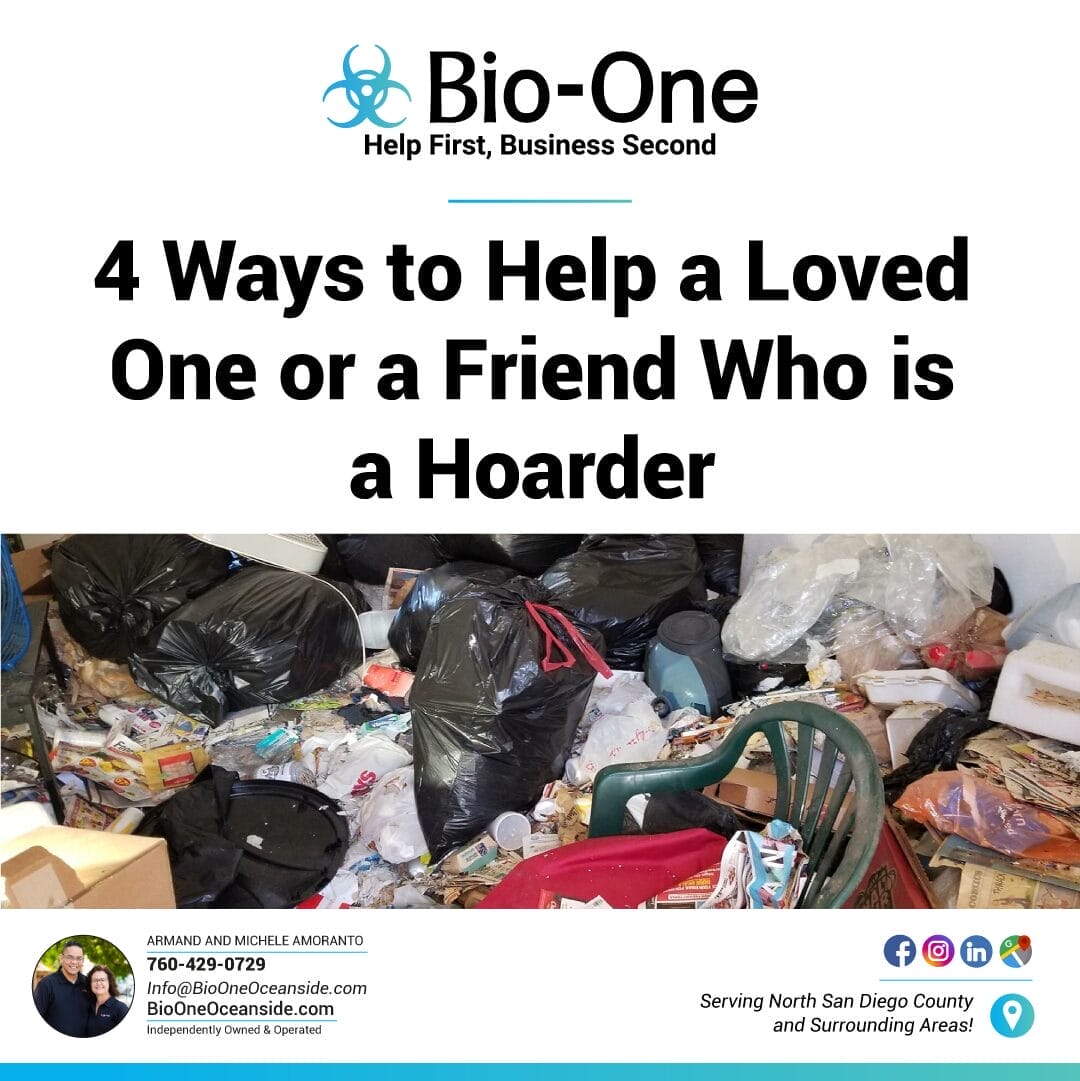
The struggle with hoarding can deeply affect not only the hoarder but also their friends and family. If you know someone who is wrestling with hoarding tendencies, it can be challenging to know how to approach them and provide the support they need. You might feel overwhelmed at what to do, and even a little scared to address the issue. Here are four ways to effective hoarder help.
Support assertion: We understand the complexities involved in restoring a home affected by hoarding. From decluttering to deep cleaning, our dedicated team approaches each situation with sensitivity and professionalism. Not only do we tackle the physical restoration of living spaces, but we also provide channels for emotional support and ongoing help for those impacted. Trust us to be a compassionate and efficient partner in your journey towards a cleaner, serene home environment.
To help a loved one who is a hoarder, begin by learning all you can about hoarding disorder. Education is the bedrock upon which informed, effective help is built. But what does educating yourself on hoarding involve?
Hoarding is more than just clutter; it's a mental health issue that drastically affects a person's day-to-day life, often resulting in significant distress and functional impairment. Recognize the hallmarks of hoarding, such as the difficulty in parting with possessions, the need to acquire items, and a strong distaste for waste, and how these characteristics impact their life.
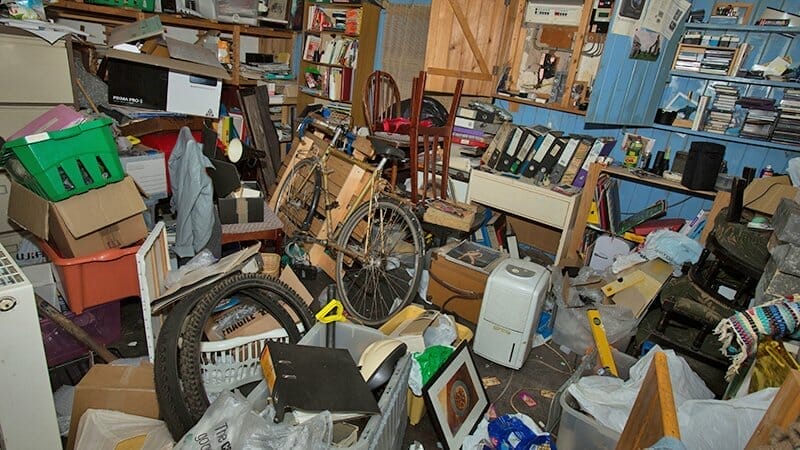
When reaching out to a friend who hoards, it's vital to approach the topic with immense empathy and understanding.
Resist the urge to label or criticize their behavior. Instead, express your concerns from a place of love and support, and make it clear that you're there to help them through this.
Offer them a safe space to express their emotions, without fear of judgment. Hoarders often feel misunderstood and alone, so your ability to listen and validate their feelings is incredibly powerful.
Simply being present for your friend can provide a significant emotional anchor. Sometimes reassurance that they are not alone in their struggle can make all the difference.

While your support is crucial, the most effective help will often come from professionals trained to work with Hoarding Disorder.
Knowledge empowers you to help your friend find the right resources. From cognitive-behavioral therapy to professional organizers with experience in hoarder help, various options can offer meaningful help. Research local therapists or support groups and familiarize yourself with their work.

Finding the right professional can be daunting, so offer to assist in this search. A hoarding specialist or support group can provide tailored guidance and a supportive community.
Sometimes the support of a loved one can make it easier for a hoarder to take the first step toward professional help. Offer to attend therapy sessions or support group meetings with them.
As your loved one with hoarding becomes better equipped to face their hoarding, practical assistance can be remarkably helpful. Approach the task of decluttering and organizing with patience and sensitivity. Set achievable goals and work at a pace that's comfortable for your friend.
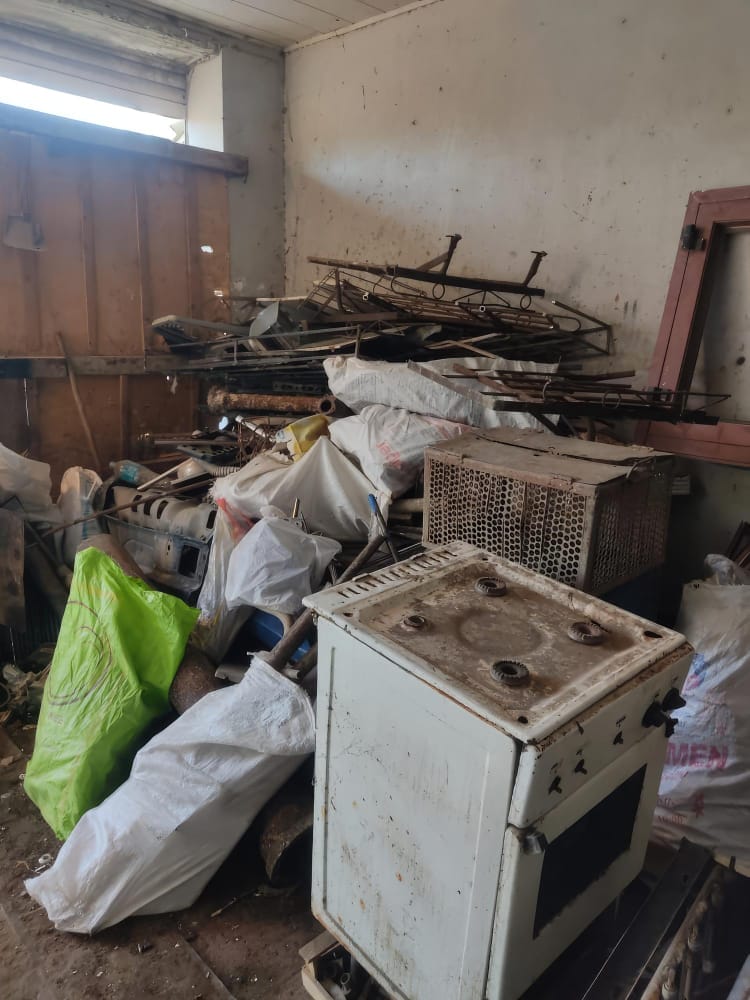
Take a look at our 4-Step Plan For a Successful Hoarding Cleaning with Bio-One.
Help them understand that decluttering doesn't mean getting rid of everything at once. Gradual releases are okay; the goal is to make decisions about possessions with increasing ease over time.
Remember, Hoarding Disorder doesn't resolve overnight. It is built on years of coping mechanisms and may take just as long to dismantle. Be patient and willing to provide ongoing support as your friend or loved one navigates their recovery.
As you embark on this path of support and understanding, remember that sometimes professional hoarding remediation services like Bio-One of Oceanside are the best way to provide a fresh start for your loved one. Bio-One's deep cleaning services are compassionate and thorough, designed to assist hoarders in parting with their items while maintaining their dignity and privacy.
Ultimately, the most important things you can offer are your time, your understanding, and your unwavering support. Together, with the right resources and allies, you and your loved one can work through the journey of overcoming hoarding.
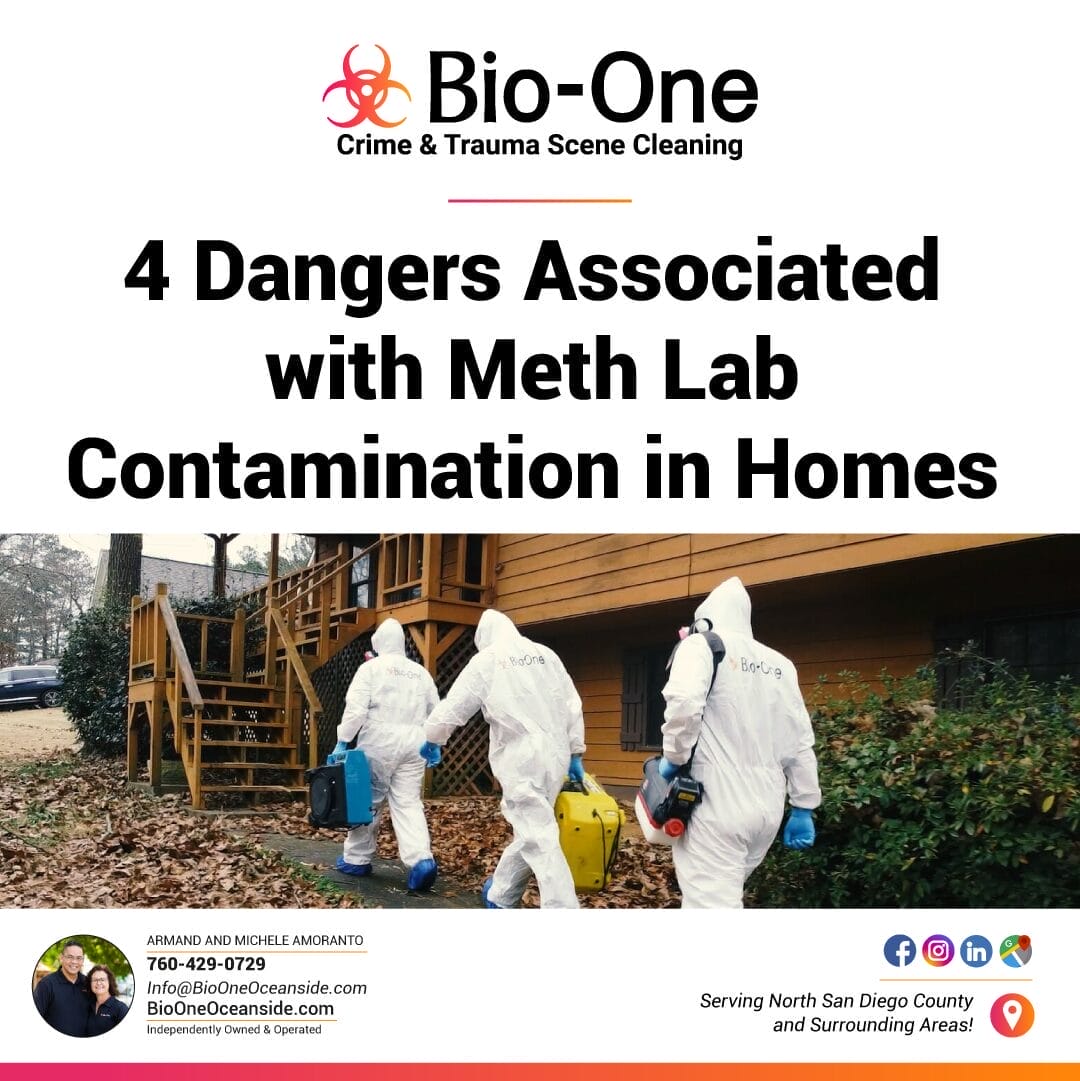
The discovery of a former methamphetamine (meth) lab in a home can shock the senses on many levels. It's not just a matter of secret drug activities being carried out in an unlikely place; it's a latent danger with profound consequences, affecting health, finances, and the very structure of the premises where it occurred. Let's shed some light on the darkness of meth lab contamination and its far-reaching dangers, and how our remediation technicians at Bio-One of Oceanside are prepared to tackle these events with expert timing.
Methamphetamine production is not only illegal but exceedingly hazardous, especially when carried out in residential environments. The chemicals used in manufacturing are dangerous to the health and environment, and the residues left behind in the home can have long-lasting consequences. For homeowners, real estate professionals, and anyone involved in property management, understanding the dangers of meth lab remediation is crucial.
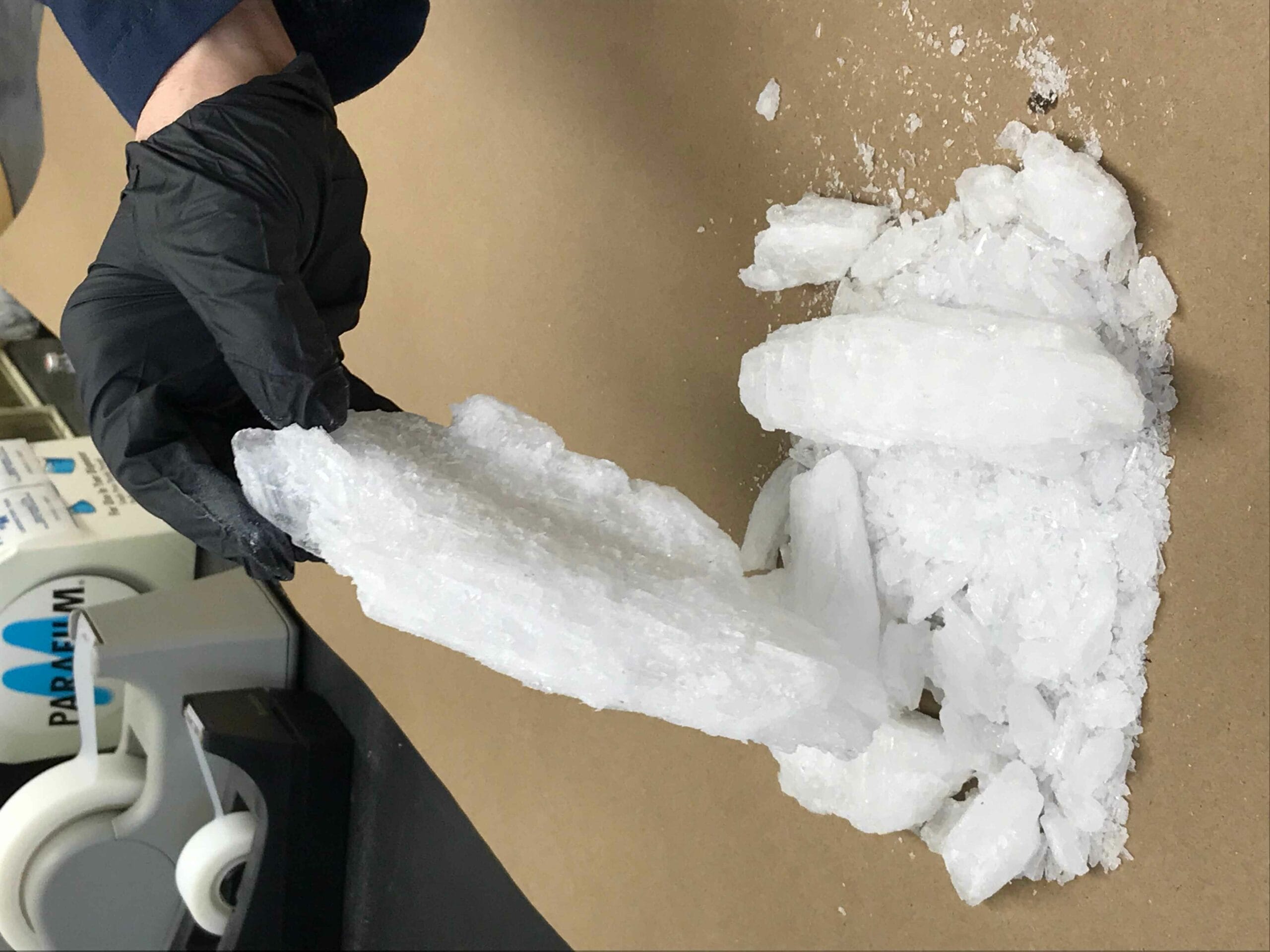
Unlike other forms of environmental contamination, meth lab residue isn't visible, and it requires specialized testing. This invisibility, combined with the severity of the associated dangers, makes it a particularly insidious threat in homes.
The most immediate and potent threat of meth lab contamination is to public health. Exposure to the residue of meth lab chemicals through ingestion, inhalation, or skin absorption can lead to severe health issues. Meth labs contaminate homes with a potent cocktail of toxic compounds, including anhydrous ammonia, lithium, and hydrochloric acid. These substances can cause symptoms from nausea and headaches to respiratory problems and organ damage.
Related news: Methamphetamine contaminated homes - a health risk?
Prolonged exposure to meth lab contaminants is linked to more severe health conditions, including cancer. The vulnerability is especially high for children, whose small bodies can't neutralize or expel these toxins as effectively as adults can.
Not only does meth lab production endanger the health of inhabitants, but it also threatens the very structure of the property.
Meth labs often feature the use of corrosive and volatile products that can cause gradual damage to a home's infrastructure: leaks, mold growth, and weakened building materials over time.
Meth lab operations are inherently dangerous. The mixing and heating of volatile chemicals pose significant fire and explosion risks, which can result in catastrophic damage to the property and pose grave dangers to those in or near the home.
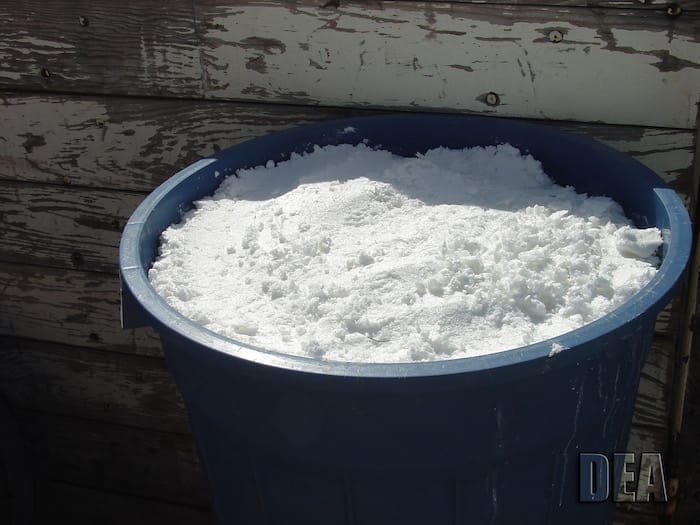
The impact of meth lab contamination extends beyond the confines of the home, creating environmental hazards that can last for years.
Meth labs not only contaminate the interior surfaces of a home but can also impact the surrounding soil, water, and air, leading to broader pollution. These chemicals seep into soil, pollute groundwater, and release toxins into the atmosphere.

The release of meth lab residues can significantly affect local ecosystems and wildlife. These chemicals can kill off plants, contaminate food sources, and cause harm to animals, creating a ripple effect throughout the environment.
Discovering a meth lab on a property can be a nightmare for homeowners and real estate professionals from a financial and legal standpoint.

The legal ramifications of meth lab contamination vary by state and jurisdiction. Homeowners can face fines, and liability for failing to disclose such contamination can lead to costly litigation.
Related: Meth Contaminated Property - County of San Diego
Removing and remediating a meth lab can be an expensive and time-consuming process. Depending on the extent of contamination, costs can range from tens of thousands to hundreds of thousands of dollars. Did you know that Bio-One works with all major insurance carriers? We offer a wide variety of options in the event of a meth lab remediation service! Learn more about our pricing and financing options!
Awareness alone isn't enough; proactive measures must be taken when it comes to meth lab remediation. If you suspect meth lab or drug contamination in a property, contact a professional biohazard cleanup service. At Bio-One of Oceanside, we specialize not only in meth lab but also in fentanyl remediation. The stakes are too high to take a chance, and the well-being of your community depends on the diligence with which we address this issue!
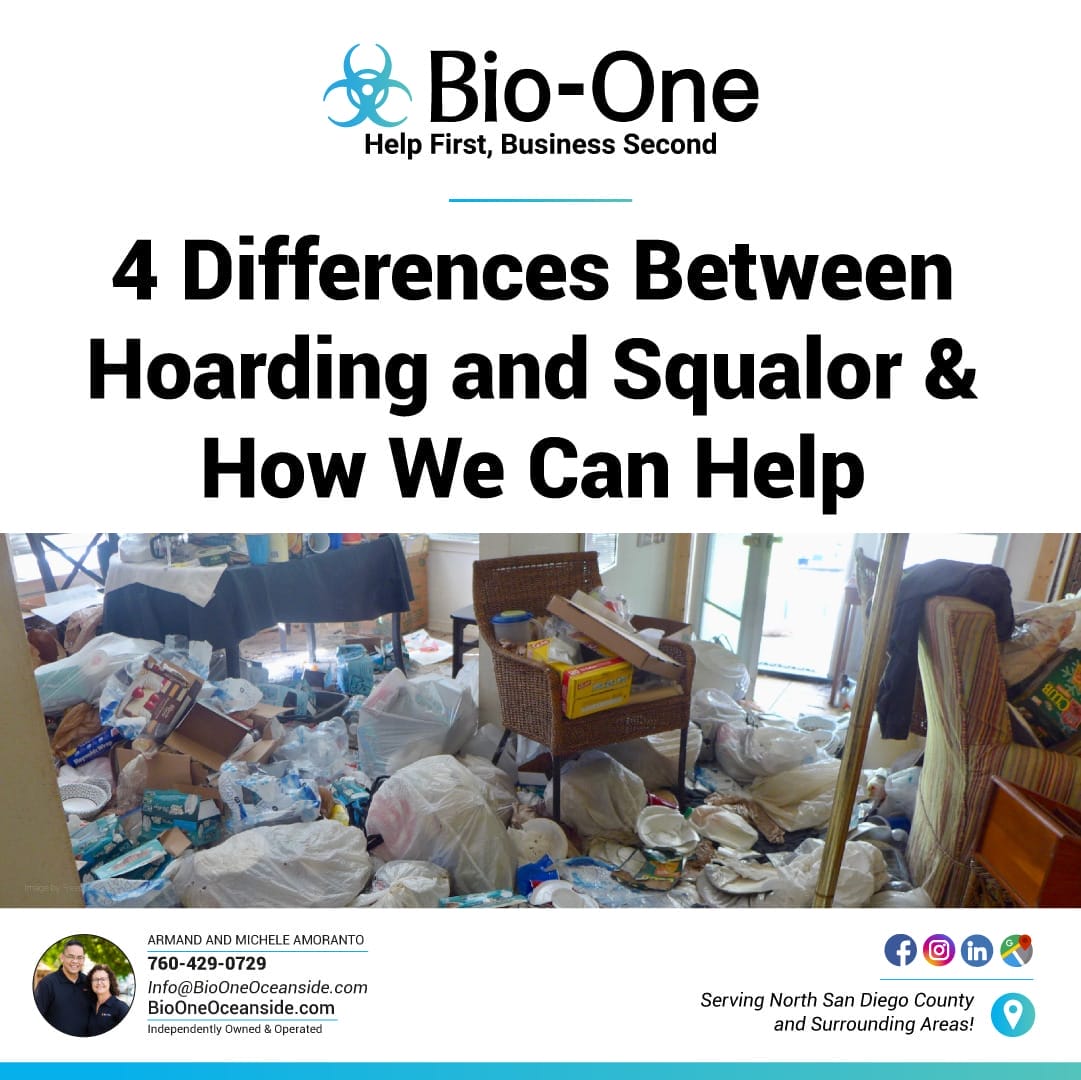
Hoarding and squalor are two terms often used interchangeably, but they refer to different situations. While both involve excessive clutter and disorganization, each has distinct characteristics and underlying causes. In this blog post, we'll explore the differences between hoarding and squalor and discuss how our team at Bio-One of Oceanside can help those affected by these issues.
Hoarding is a mental health disorder characterized by an excessive accumulation of items and difficulty discarding them. People who hoard have a strong emotional attachment to their possessions, often believing that they will need them in the future or that they have sentimental value. Hoarding usually results in overwhelming clutter that can impede daily living activities and pose safety hazards.
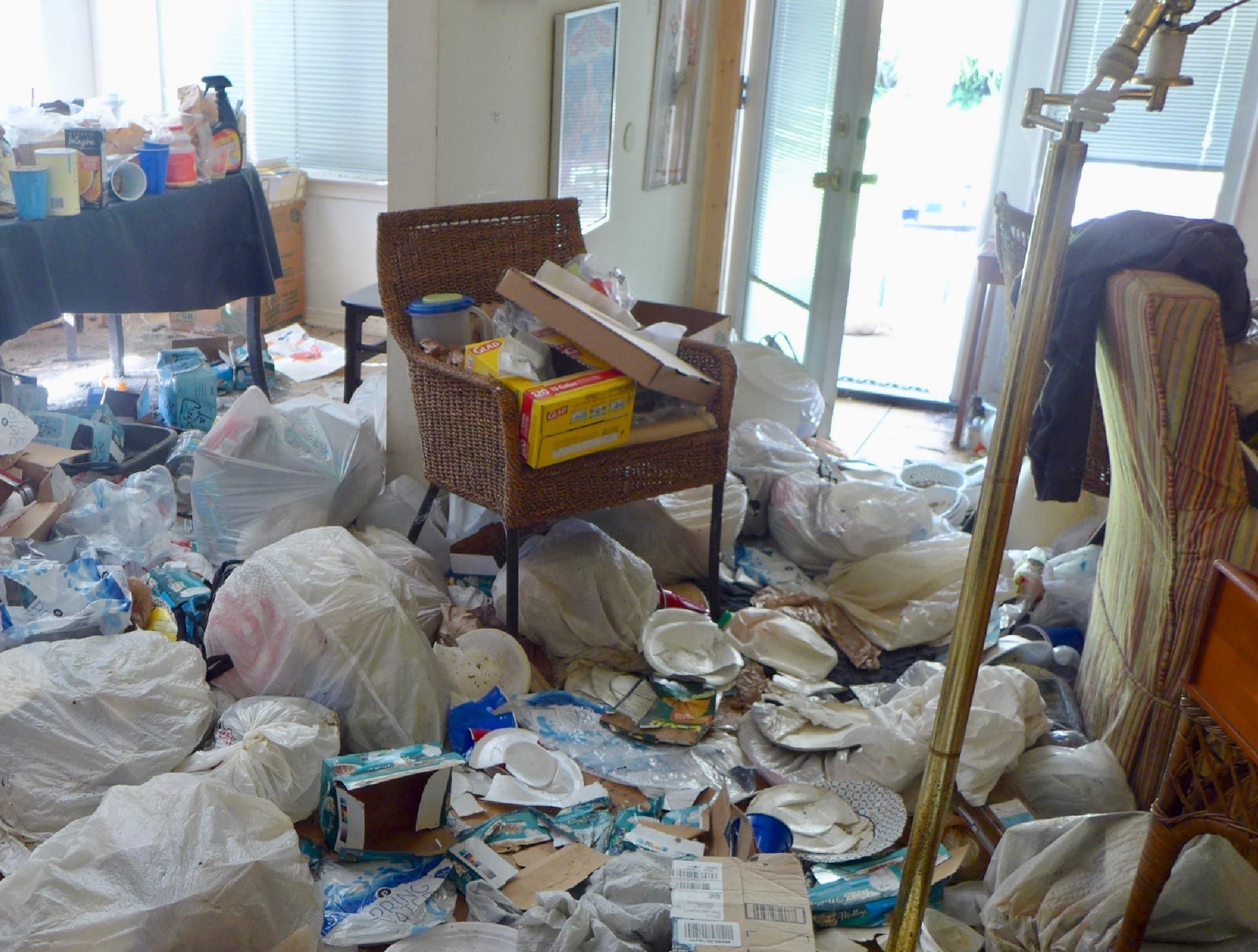
Squalor, on the other hand, refers to a living environment that is extremely unclean and unsanitary. It often occurs as a result of neglect or an inability to maintain a clean living space. People who live in squalor may not necessarily have a hoarding disorder, but they struggle with keeping their living space clean and organized.
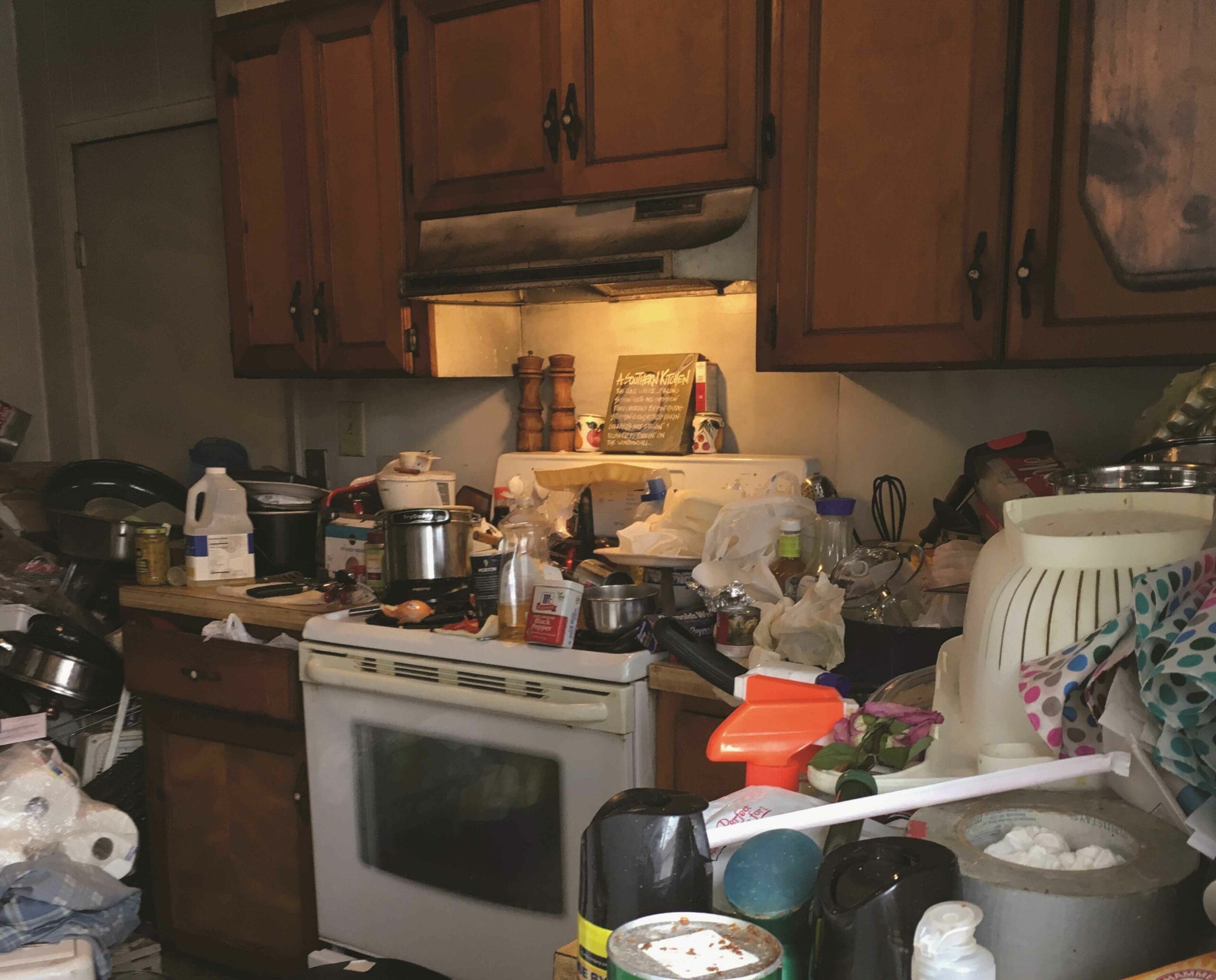
Hoarding and squalor can often occur together, but they are not the same thing. While hoarding is a mental health disorder, squalor is a symptom that can result from it. For example, a hoarder may have difficulty discarding items, leading to excessive clutter and eventually squalor.
However, not all hoarders live in squalor, and not all people living in squalor have a hoarding disorder. Both conditions can coexist or occur separately. Treatment for hoarding does not necessarily address the squalor, and vice versa.
While both conditions manifest in poor living conditions, each arises from distinct causes and has unique characteristics. Here are four key differences between hoarding and squalor:
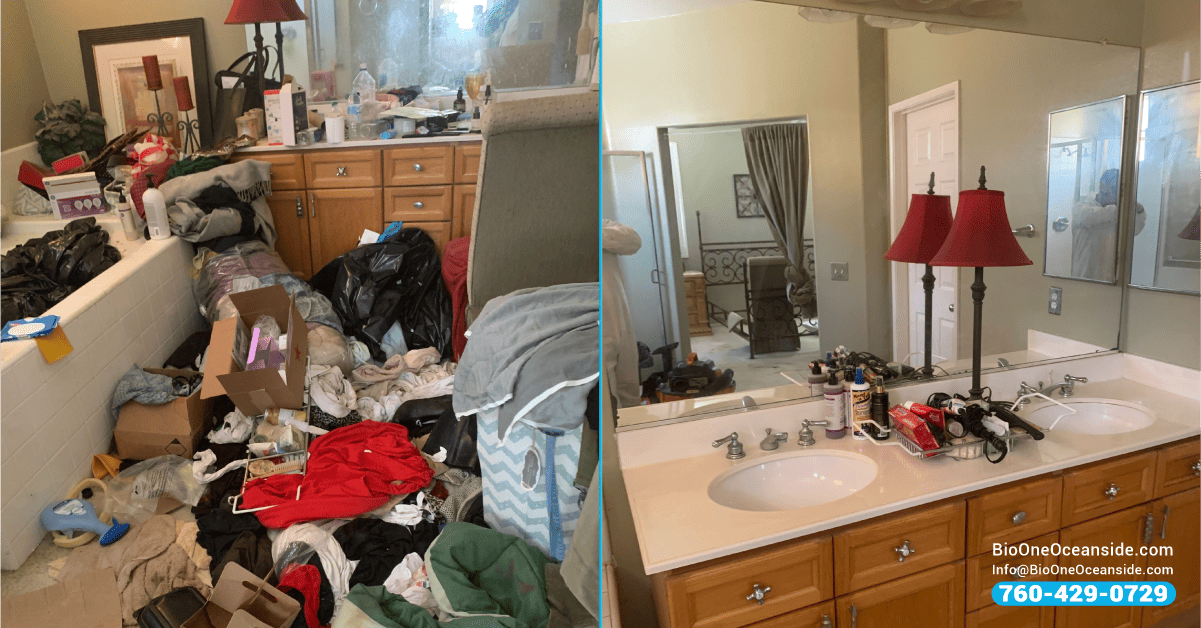
With proper treatment and support, both hoarding and squalor can be overcome. Here are some ways to address these conditions:

One common misconception about Hoarding Disorder is that it is a choice or a result of laziness. However, research has shown that HD is a complex condition influenced by factors like genetics, brain structure and function, and life experiences. Therefore, it's essential to approach treatment with empathy and understanding.
Furthermore, recovery from hoarding is not a one-time event; it requires continuous support and effort. Even after completing a treatment program, individuals may still struggle with triggers and relapses. Therefore, seeking ongoing support is crucial in maintaining progress and preventing a relapse.
Here at Bio-One of Oceanside, we understand the challenges faced by individuals struggling with hoarding and squalor. Our trained professionals offer compassionate and discreet services to help declutter and restore living spaces affected by any of these scenarios.

Additionally, we provide ongoing support and resources to assist individuals in maintaining a clutter-free environment. Our team is committed to helping those with hoarding overcome their challenges and accomplish a healthier, happier life. If you or a loved one is struggling with hoarding and squalor, don't hesitate to reach out to Bio-One of Oceanside. We are here to help and support you every step of the way!
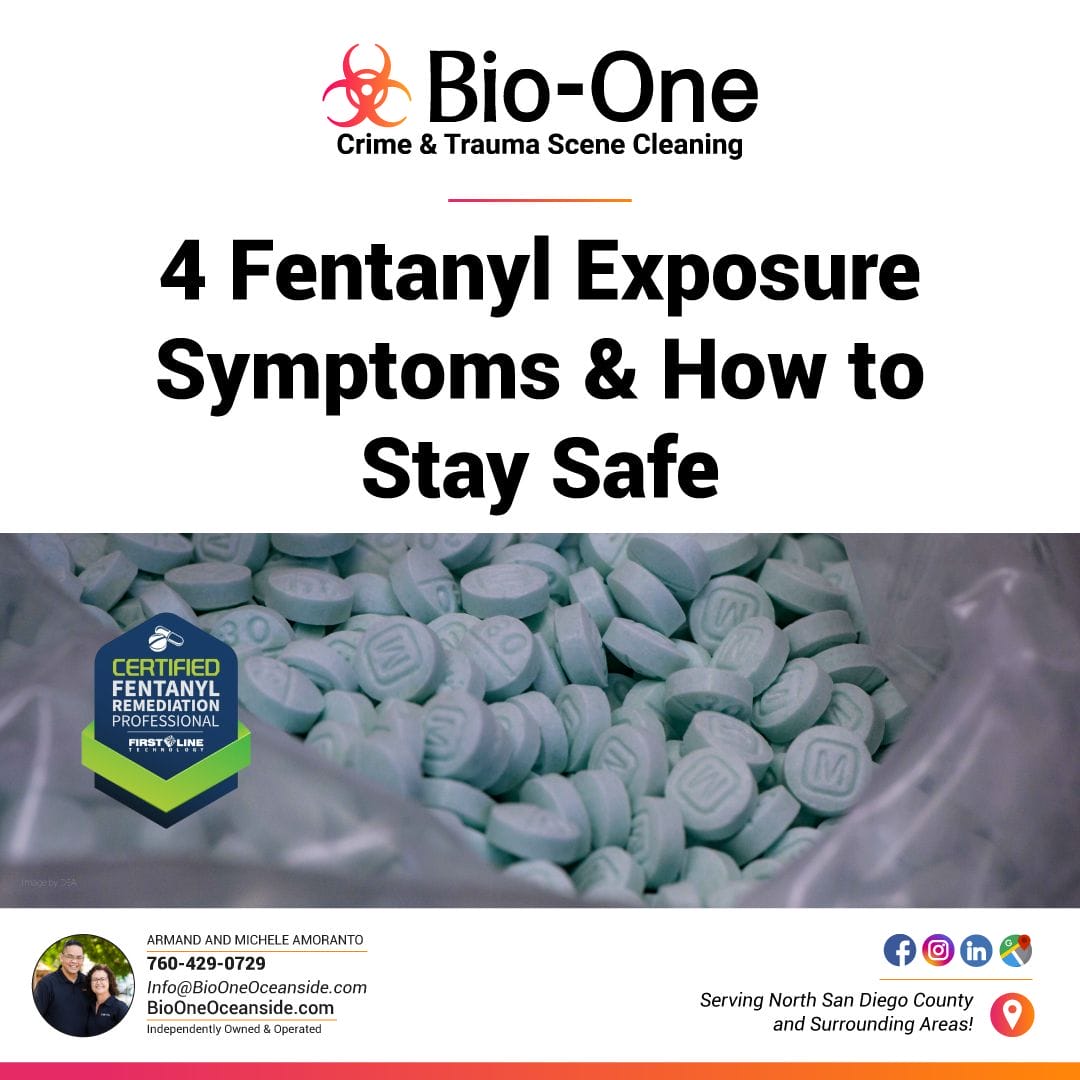
Fentanyl is a synthetic opioid commonly used for pain management. Unfortunately, it has gained popularity as an illicit drug that is illegally produced and distributed on the streets. The potency of fentanyl is one of the reasons why it is so dangerous. Even small quantities can cause severe respiratory depression, leading to accidental overdose. In this blog post, we will discuss four fentanyl exposure symptoms and how to stay safe while handling this deadly drug.
Fentanyl exposure can cause respiratory distress, meaning it can suppress the body's ability to breathe. Symptoms of this include shallow breathing, slow breathing, or even complete cessation of breathing. In some cases, fentanyl exposure can lead to respiratory arrest and death if not treated immediately.
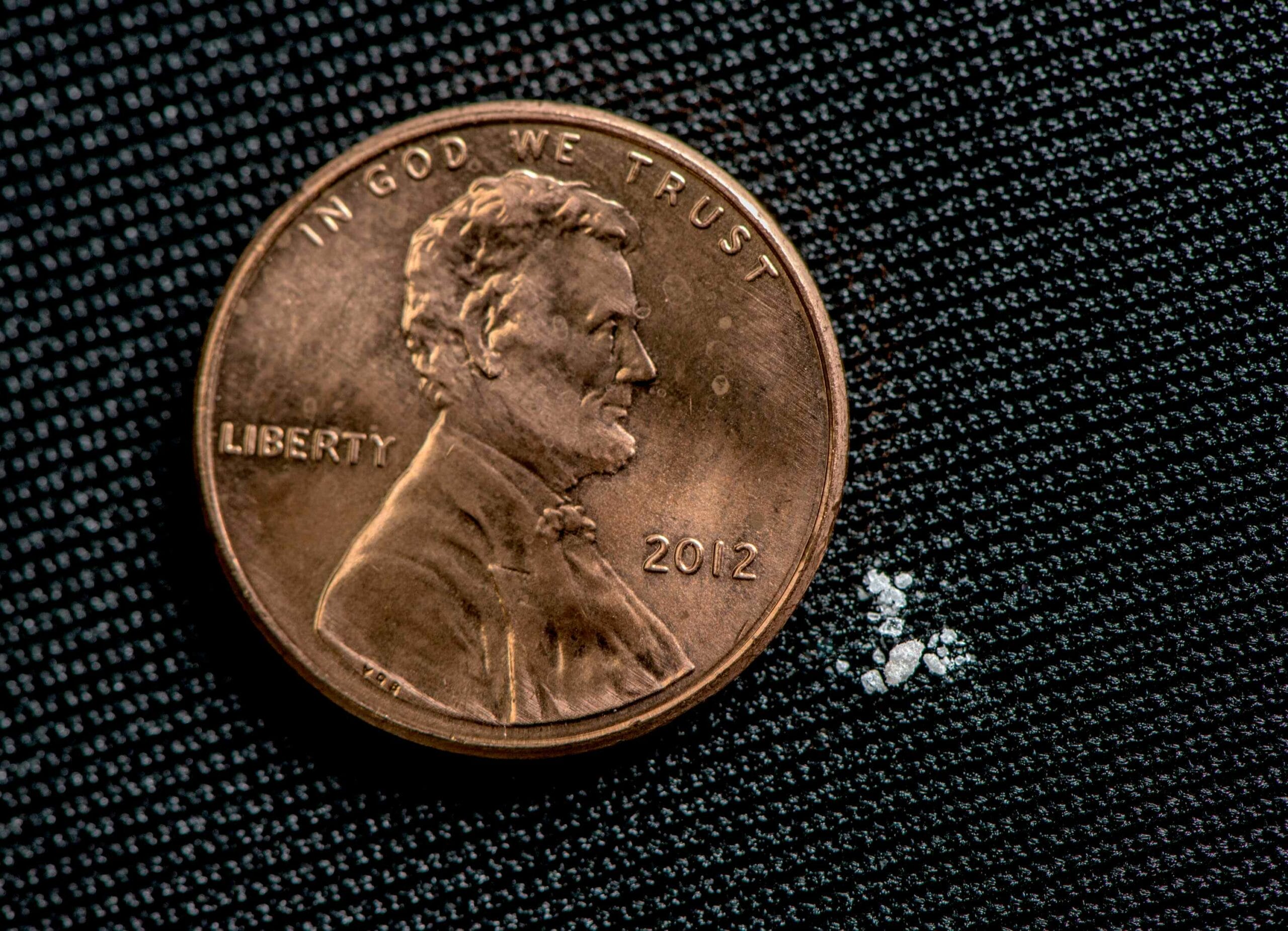
One of the most visible signs of fentanyl exposure is cyanosis, which is a bluish discoloration of the lips and nails. This occurs when there is a lack of oxygen in the blood due to respiratory distress. If you notice someone with blue lips or nails, it could be a sign of fentanyl overdose and should be treated as an emergency!
Fentanyl exposure can also lead to nausea and vomiting, which are common symptoms of opioid overdose. This occurs due to the disruption of the body's natural balance caused by fentanyl.
In severe cases of fentanyl exposure, the individual may experience stupor, which is a state of near-unconsciousness. They may also become completely unconscious and unresponsive. These are critical signs of overdose and require immediate medical attention.
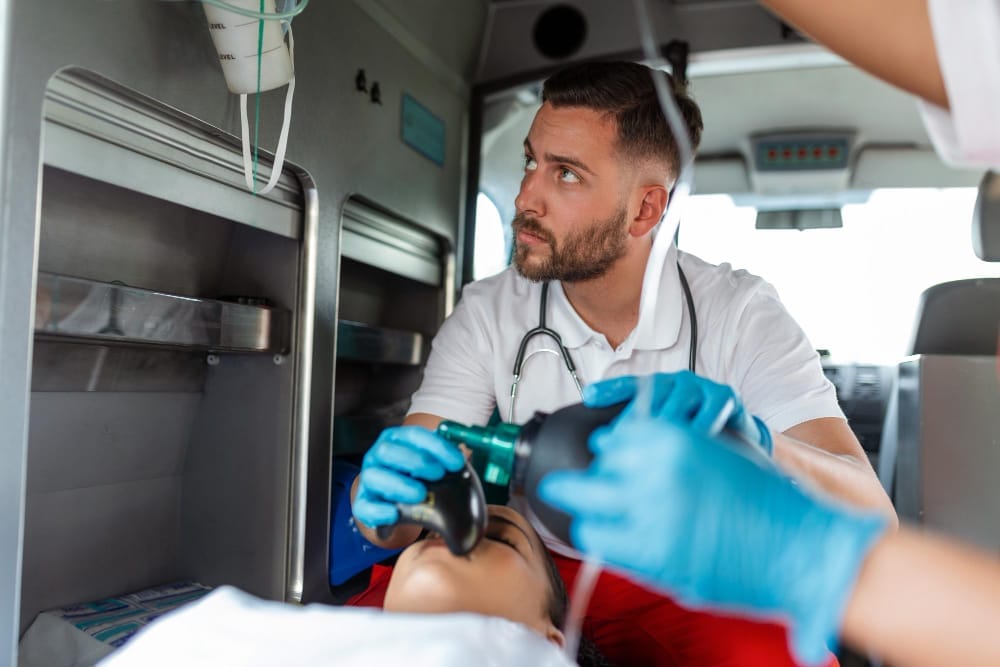
Aside from the four main symptoms discussed above, fentanyl exposure can also cause:
In extreme cases, fentanyl exposure can also cause seizures, coma, and death. If you suspect exposure to fentanyl, it is critical to call emergency services right away. Time is of the essence, and prompt medical attention can make all the difference.
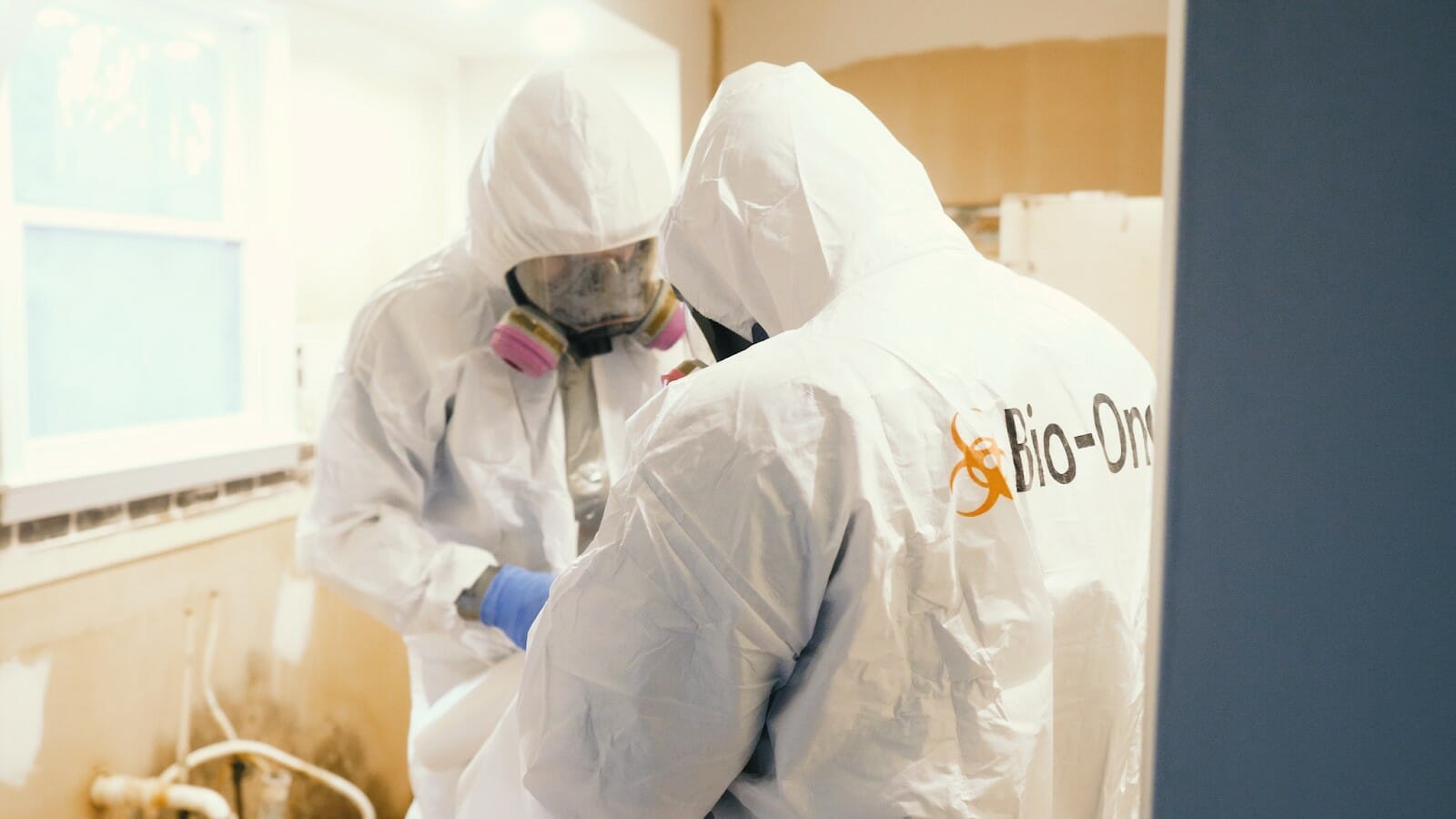
Fentanyl is a potent opioid that should be handled with extreme caution. If you are required to handle fentanyl in your job (as an emergency responder, for example) or personal life, here are some tips to keep yourself safe:
Learn more: 4-Step Plan For a Safe Fentanyl Cleanup After an Overdose
As mentioned earlier, naloxone is an opioid overdose reversal medication that can save lives in case of accidental fentanyl exposure or overdose. It works by quickly binding to the same receptors in the brain as fentanyl, blocking its effects and potentially reversing an overdose.

Naloxone comes in different forms, including nasal spray and injectable versions. In most cases, it is available over the counter without a prescription. If you know someone who may be at risk of fentanyl exposure, it is highly recommended to have naloxone on hand and learn how to use it correctly.
In conclusion, fentanyl is a dangerous drug that can have fatal effects, especially without proper safety measures. Early detection is crucial in avoiding severe outcomes. If you have been exposed to fentanyl and need professional remediation services, Bio-One of Oceanside has the expertise and tools you need to keep your surroundings safe and clean. Don't hesitate to call us for assistance. Stay safe and take care of yourself and others!